
* A Distributed Proofreaders Canada eBook *
This ebook is made available at no cost and with very few restrictions. These restrictions apply only if (1) you make a change in the ebook (other than alteration for different display devices), or (2) you are making commercial use of the ebook. If either of these conditions applies, please contact a FP administrator before proceeding.
This work is in the Canadian public domain, but may be under copyright in some countries. If you live outside Canada, check your country's copyright laws. IF THE BOOK IS UNDER COPYRIGHT IN YOUR COUNTRY, DO NOT DOWNLOAD OR REDISTRIBUTE THIS FILE.
Title: Whistling as an Art
Date of first publication: 1925
Author: Agnes Woodward (1873-1938)
Date first posted: Jan. 5, 2018
Date last updated: Jan. 5, 2018
Faded Page eBook #20180108
This ebook was produced by: David T. Jones, Linda Hamilton, Cindy Beyer & the online Distributed Proofreaders Canada team at http://www.pgdpcanada.net

TRANSCRIBER NOTES
Misspelled words and printer errors have been corrected. Punctuation has been maintained except where obvious printer errors occur.
The HTML version of this book includes midi versions of the music and you can play them using the midi-player on your device by selecting the “[Listen]” link below each piece of music. A piano “voice” has been used in the midis so that whistlers can more easily hear themselves as they whistle along with the samples.
Midis do not include ornaments or whistling effects. We have also not included repeats and redirects for the musical selections prepared for solo use. Music notation that includes only a single note has not been converted to midi format.

“It was the warbling of the birds which
first gave man the thought of music”
Claude Debussy.
CLAUDE DEBUSSY
WHISTLING AS AN ART
A METHOD FOR THE DEVELOPMENT OF
TONE, TECHNIC AND STYLE
WITH
MANY MUSICAL SELECTIONS PREPARED
FOR SOLO USE
BY
AGNES WOODWARD
Director, Agnes Woodward School of Whistling
Los Angeles California
Price $2.50
in U. S. A.
CARL FISCHER, Inc.
Cooper Square
Boston NEW YORK Chicago
Copyright, 1923
by
AGNES WOODWARD
Copyright, 1925
by
CARL FISCHER, Inc.
New York
International Copyright Secured.
Revised and Augmented Edition
Copyright, 1938
by
CARL FISCHER, Inc.
New York
International Copyright Secured.
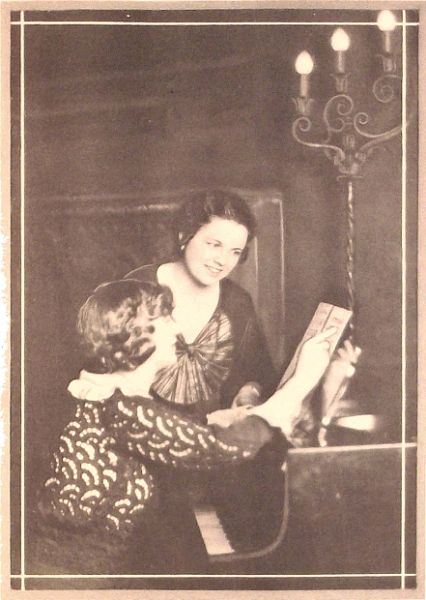
Miss Woodward explaining some intricate bird-figures
to one of her artist students.
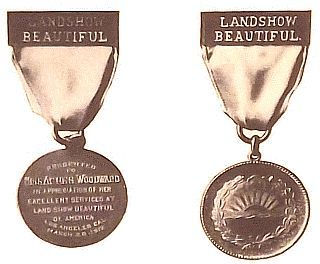
Copy of medal presented to Miss Woodward by the Realty Board of Los Angeles, at the closing entertainment of the Land Show Beautiful of America, which convened for two weeks, and at which her Whistling Chorus of 30 girl whistlers appeared six times with great success.
DEDICATION
To my dear mother who has been my best critic; and to my aunt who has been my loyal accompanist and helper during the formulative period of this interesting study—this little book is affectionately dedicated.
THE AUTHOR.
This work, the result of many years of study, observation and experience, is offered to the public in the hope that it may materially help aspiring whistlers toward furthering their innate talent and gain for them a true insight into the processes for the development and cultivation of the human whistle.
THE PUBLISHERS.
CONTENTS
| Foreword | IX |
| An Appreciation (L. E. Behymer) | X |
| Whistling | XI |
| Whistles and Whistlers | XII |
| Breath Control | XIII |
| Vibration | XIV |
| Terms and Symbols used for Tongue Strokes | XV |
| Lesson I. | General Development, Legato, Staccato | 1 |
| The Bird Chirp | 2 | |
| The Hewie Chirp | 3 | |
| The Reverse Chirp | 4 | |
| The Wave and the Trill | 5 | |
| Breadth and Range | 6 | |
| Lesson II. | The Quitta, the Mordent | 7 |
| The Triplet | 8 | |
| Triple-Tonguing | 10 | |
| Various Exercises | 11 | |
| Lesson III. | The Whip, the Upward Cry | 15 |
| The Downward Cry | 16 | |
| The Whit-cha and Whit-cha-Koo | 17 | |
| The E-chew, the Quitchaquia | 18 | |
| Lesson IV. | The Yodel | 19 |
| The Hedala, the Cudalee, the Lup | 20 | |
| The Lup-ee | 21 | |
| The E-Lup, the Lah-ee, the Lee-ah | 22 | |
| The Chut-ee | 23 | |
| Lesson V. | The K Stroke | 25 |
| Mocking Bird Notes | 26 | |
| Lesson VI. | Spiral or Rolled Yodels | 26 |
| Dipped Yodels, E-lup with E-Yodel | 27 | |
| Lup-ee with E-lup, Descending Chromatic Scales, Staccato | 28 | |
| Combination of Familiar Figures | 29 | |
| Lesson VII. | Bird Exercises, Combinations | 31 |
| Octave Exercises | 32 | |
| Lesson VIII. | Bird and Staccato Exercise | 33 |
| The Thrup-ee and E-thrup | 34 | |
| Ascending and Descending Quivers | 35 | |
| Lesson IX. | The Turn | 35 |
| Turn and Various Exercises (Long Staccato Chrom. Exercise, etc.) | 36 | |
| Lesson X. | Chirps (further explanation) (with various exercises) | 38 |
| Lesson XI. | The Lup (further explanation) (with various exercises) | 41 |
| Lesson XII. | The Hedala, General Practice of | 43 |
| Meadow Lark Song | 45 | |
| Yodel Exercises | 46 | |
| Additional Bird Songs | 47 | |
| Lesson XIII. | Trill (further treatment) | 49 |
| Additional Exercises for General Practice | 52 |
| Additional Combination Figures (written with Symbols) | 59 |
| Bird Calls and Bird Songs | 60 |
| Notes. Various Suggestions for Whistlers | 64 |
| Exercises for Advanced Students | 70 |
| Whistling Examination Questions | 74 |
WHISTLING SELECTIONS
(Music and Explanatory Key)
| Moon Winks (Stevens) | 77 |
| Mother Machree (Olcott-Ball) | 79 |
| Roses of Memory (Hamblen) | 82 |
| The Bluebird (Kummer) | 85 |
| Chinese Lullaby (Bowers) | 88 |
| Manzanillo (Robyn) | 91 |
| The Star (Rogers) | 94 |
| You, Dear and I (Clarke) | 96 |
| Adieu (Friml) | 98 |
| ’Neath the Autumn Moon (Vanderpool) | 102 |
| In Poppyland (Albers) | 106 |
| Valse Parisienne (Roberts) | 111 |
| God Touched the Rose (Brown) | 115 |
| Listen to the Mocking Bird (Winner) | 117 |
| Liebesfreud’ (Kreisler) | 123 |
| Love Sends a Little Gift of Roses (Openshaw) written with whistling symbols only | 128 |
| Nocturne Op. 9, No. 2 (Chopin), written with whistling symbols only | 129 |
| Bird Secrets | 130 |
| Two Little Magpies (Wells) | 132 |
| List of Whistling Selections | 134 |
At one time whistling was considered unattractive and even unbecoming in a young woman. Of late years, however, concurrent with the progress and advancement of art, the potentialities of the human whistle have become most apparent. Today the professional whistler, particularly one possessing the gift of bird imitations, is much in demand for concerts and similar entertainments.
Bird songs, it is prophesied, may become the basic themes for far more music than folk songs. This, at least, is the prediction of Mrs. H. H. A. Beach, well-known composer, who has been making experiments along this line in the MacDowell Woods in New Hampshire. “My studio at Peterboro was surrounded on three sides by beautiful birch trees, the front facing a wide view of valley and mountains. In the deep woods near by, the hermit thrushes sang all day long, so close to me that I could notate their songs and even amuse myself by imitating them on the piano and having them answer. The songs were so lovely and so consonant with our scales that I could weave them into piano pieces as easily as I could have used folk songs. It was a labor of love indeed and I only hope that I have succeeded in giving at least a slight impression of their exquisite rhythm and melodic beauty.”
If bird songs may be successfully incorporated into piano music and whistling (and in the latter case the exact reproduction is not only possible, but is accomplished with absolute accuracy) then there is an infinite field of beauty and variety from which such themes may be drawn.
————
The foremost essentials of a good whistler are: pleasing tone quality, flexibility of tongue, adequate range (at least two octaves or more), correct breath control, and bird imitations with an intelligent understanding of their use. Personality is also an important factor in the making of a successful public whistler. Add to these qualities the necessary finish and the proper interpretation and presentation of a whistling selection, and the whistler at once receives merited recognition.
During the fifteen years of my experience as a teacher, I have learned that the bird notes are as easily acquired in the beginning lessons of the study as later, and for this reason, many of the bird notes and figures are given in the first five lessons. Some few changes may be necessary to suit the needs of certain pupils, but in the main, the lessons should be followed as outlined in the book.
It should be borne in mind, however, that this system is primarily intended for pucker whistling, although many of the figures and exercises may be employed by “tongue and teeth whistlers” and various bird imitators.
AGNES WOODWARD.
Artistic Whistling is an acknowledged art and as such has gained much popularity the past few years, now ranking in marked prominence with other musical arts. To be sure, not all whistling is artistic whistling, but the true musician, the connoisseur, and the discerning listener, will readily detect the difference.
Miss Agnes Woodward of Los Angeles, California, for many years a prominent exponent of this unique form of musical expression, has devoted much time and thought to the study of bird-like whistling and now offers the public a book for the development and cultivation of nature’s instrument. In this little volume, she deals with various forms of bird songs, exercises for development, breadth, and enrichment of the whistle, as well as comprehensive and concise explanation of all figures.
From her study of the birds and their many songs, Miss Woodward has evolved an original system called “The Woodward Method of Bird Whistling.”
Miss Woodward is not only the originator of this unique system of bird whistling but is also the Director of the Agnes Woodward School of Whistling: the Conductor of “America’s Bird Whistling Chorus” of thirty whistlers: and is the only woman whistler to hold a gold medal for excellency in the whistling art.
Many of the finished whistlers on the American stage today have been students at this school. Its artists have filled engagements on the Orpheum and Keith Circuits; on the Pantages; at the Hippodrome in New York, also at the Music Box Review; have toured in England, Scotland, Wales, Australia, New Zealand and South America: made records for the different phonograph companies; filled engagements with the Harry Lauder Company; completed many different seasons’ engagement with the various Chautauqua and Lyceum Bureaus; engaged in concert work; appeared with great success at the different moving picture houses; and have been regularly paid church soloists in Oakland, California, in Los Angeles, and elsewhere. Students have also filled successfully many radio programs.
L. E. BEHYMER
NOTE:—Mr. Behymer, one of the world’s greatest impressarios, well-known musically on two continents, has received high honors from both the French and Italian Governments—from the former the “Order of The Palms,” constituting him “Officer d’Academie”—and from the latter the “Crown of Italy,” carrying with it the office of Cavalier (Cavalier della Corona d’Italia).
WHISTLING AS AN ART ranks high in comparison with other musical arts. It is not a fad. It is refined, and when properly rendered, artistic and beautiful. It furnishes a happy medium for musical expression to those who are unable to sing or execute musically in other lines.
WHISTLING AS A BENEFIT TO HEALTH is unsurpassed. It strengthens, by the constant practice of deep breathing, the lungs, the throat and diaphragm.
WHISTLING AS AN ACCOMPLISHMENT is always attractive and much in demand. The rendition of bird-songs is always interesting and pleasing.
WHISTLING AS AN ENTERTAINMENT is most unique and popular. There are few programs now-a-days which do not have the added attraction of a bird-whistler.
WHISTLING AS AN EDUCATIONAL FACTOR develops the power of observation and imitation, and leads to the study of bird life and bird habits.
WHISTLING AS A VOCATION furnishes to the competent and finished solo whistler a remunerative and satisfactory livelihood in concert, in Chautauqua and Lyceum work, in vaudeville, moving picture houses, and other places of entertainment, as well as in special solo work in church services. As a stable and reliable income to the intelligent and capable instructor, it is most lucrative.
There are various classifications of whistles as to range and quality—soprano, mezzo, and alto;—lyric, coloratura and dramatic.
———
There are also various types of whistlers—the “pucker whistler,” the “tongue and teeth whistler,” the “palate whistler,” and occasionally the “throat (or ventriloquial) whistler.”
———
The usual range of the average whistler is an octave and a little over, possibly an octave and a half. Two octaves is considered good; two and a half exceptionally good; and three octaves and over, unusual.
———
A soprano whistler should be able to take high “B flat” and possibly “C”. Occasionally there are whistlers who are able to whistle several notes higher, even to “F” above high “C”. In the lower register, they usually whistle “B” and “B flat” below middle “C”, and sometimes lower.
———
A mezzo whistler usually covers a range of “A” below middle “C” to “G” above the staff.
———
An alto whistler has practically the range of the mezzo with the exception of several notes added in the lower register, some altos reaching “E” and “D” below middle “C”.
———
Exercises for extending the whistling range, either higher or lower, will be found on pages 6, 7.
In whistling, as in singing, the deep breathing (diaphragmatic breathing) is employed. The diaphragm is a strong muscle, arched in shape, upon which the lungs rest, and which forms a partition between them and the abdominal organs. When inhaling, the diaphragm lowers and distends, thus giving room to the increased body of air in the lungs. Breathe through the nostrils slowly, filling both lower and upper lobes of the lungs. Hold a second and during exhalation allow the diaphragm to recede slowly to its normal position. For the production of tones to be held for some time, this process retains the breath longer than chest breathing, and is the only correct method for whistling.
It should be understood that the air leaves the upper lobes of the lungs first, being followed by that in the lower lobes, at which time the diaphragm recedes slowly to its natural position. Regular breathing exercises should be practised daily for the development of perfect control.
Place the hands on the sides, thumbs supporting the muscles of the sides, inhale through the nostrils, counting 10 slowly during inhalation, hold while a count of 5 is made, and then exhale during a count of 20, or until the breath is entirely eliminated. Repeat this exercise several times a day, preferably just before practice of whistling. By this means the muscles of the diaphragm become strong, firm and pliable, and are able to retain the distended position much longer than when first tried. Also much longer passages in whistling may be executed with greater ease.
Another exercise for the development of the diaphragmatic muscles is as follows: Place the hands on the sides (position as mentioned above), thumbs bracing the body, and slowly while inhaling, bend the body backward, until the muscle in the pit of the stomach pulls considerably, then slowly let the body return to first position, exhaling gradually. By constant practice, this body-bending exercise produces excellent results, even without thought of the breath. Be sure, however, that the motion backward is gradual and easy, and not jerky or spasmodic.
In whistling, the chin and lips (particularly the lower one) are tensed, the tongue is allowed to be loose and flexible, and the support (propelling power) comes from the diaphragm. The tone is focussed and controlled by the lips which are immobile during the actual production of the sound, while the work is executed by the tongue.
In high notes (plain) the tongue lies near the upper edge of the lower teeth (inside), great tension being felt in the lip and chin muscles.
In the low notes (plain) the tongue lies easily against the lower part of the lower teeth (inside), and on very low tones, draws back in the mouth away from the teeth, and there is the sensation of a cavity being formed in the center.
The chest should be elevated at all times: the feet together, the left foot a little in advance of the right foot, the heel resting against the instep of the right foot and the weight of the body thrown over the balls of both feet, thus giving proper position and poise.
Vibration is a quality in the whistle corresponding to the resonance in the singing voice. It is produced by a slight quivering of the front of the tongue, particularly along the sides. Although not absolutely necessary, it is a quality which greatly enhances the whistle and produces a pleasing and sympathetic tone.
Moving the tongue rapidly back and forth in the mouth while continuously whistling, materially aids in acquiring this quality. The rapid practice of the wave, will also help to bring about desired results.
The motion of the tongue while vibrating has been likened to shivering. Any person who has been cold to the point of chills will understand the effect of shivering and its action on the tongue.
The vibrant quality should be more or less constant during the whistling of a selection, but never excessive, and never in evidence during the making of the bird figures. Keep it well under control.
To regulate too excessive vibration, tense the tongue more decidedly, and hold firmly both the under-lip and the chin.
There are some whistles so overloaded with vibration that they become shaky and uncertain, and (as a rule) fall below the desired pitch. Great care should be exercised, especially while executing bird-figures that the tone is clear and distinct, and not blurred, uncertain, or flat in pitch.
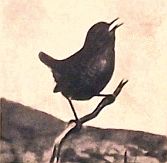
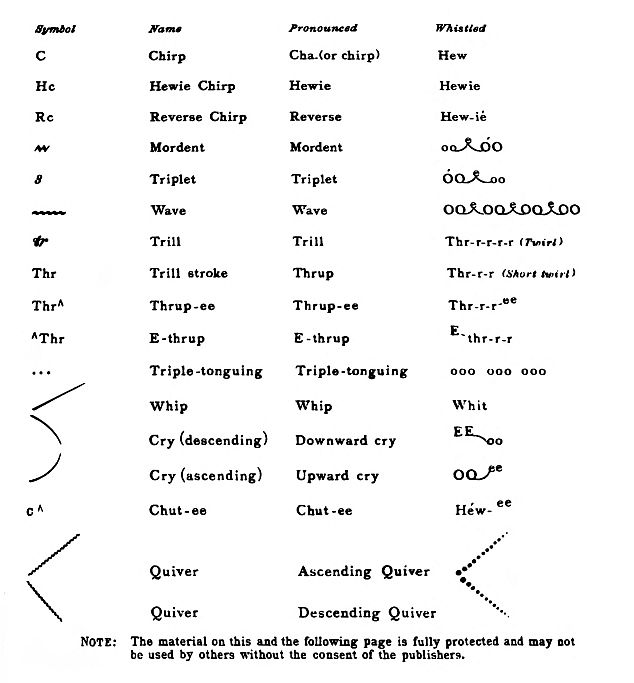
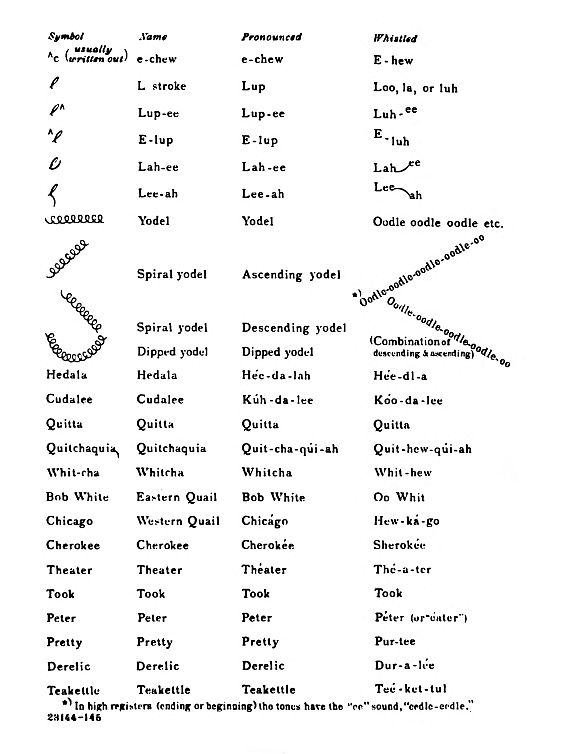

| [Listen] | [Listen] | [Listen] |
| Hick - o - ry | Kill - deer | Yá - hoo |

| [Listen] | [Listen] | [Listen] |
| Dee - dee | Qúi - ah | Ged-dy up |

| [Listen] | [Listen] | [Listen] |
| Wér - wi - dee | Túr - key | Ku - dé - o |

| [Listen] | [Listen] | [Listen] |
| Oó - lup | Hić - cough | Pét - ty - coat |

| [Listen] | [Listen] | [Listen] |
| Dig - e - ro | Whit - too | Kee - o - kúk |

| [Listen] | [Listen] | [Listen] |
| Héw - oo | Dee dee déep | Cheer-i - ly |

| [Listen] | [Listen] | [Listen] |
| E-sćare-cow | Hew-ah - éw | Uŕ - tee |

| [Listen] | [Listen] | [Listen] |
| Teá-ket-tle - tea | Déar - ie | É - thrup |

| [Listen] | [Listen] | [Listen] |
| Take cáre | What year | Who are you? |

| [Listen] | [Listen] | [Listen] |
| Pe - ter did it | Eat lit - tle | Louie, eat your cookie |
Whistling as an Art
by
AGNES WOODWARD
For daily practice take the scales and arpeggios in the different keys, first legato (smooth), and then staccato (short and sharp), whistling the staccato work much more rapidly than the legato work.

[Listen]
Watch carefully that the notes connected by curved lines are whistled smoothly and evenly, and that the staccato notes are taken up briskly and with decision. It has been found sufficient for the general building of the whistle, to dispense with the minor scales, using only the major scales.

[Listen]
| Whistle very smoothly and connectedly from one note to the next. | Whistle staccato notes briskly and with decision. |
A good exercise combining legato and staccato work is the following:—

[Listen]
Practice this exercise in the different keys. The practice of legato work gives breadth and fullness to the tones, and the practice of staccato work gives brilliancy and pointedness. The check ⩗ indicates breathing point.
The Bird Chirp (sometimes called the Little Bird Chirp and indicated by the character “c”), is a figure comprised of two notes, a grace note above from which a very quick slide is made to a longer note below, thus;—

Be sure to slide smoothly from the grace note to the note below. When done very quickly, as in successions of chirps, the grace note comes a semi-tone above the long note thus:—

but is not expressed in writing on the staff. The figure has the sound of “hew”. The bird chirp is one of the downward figures and is always very short and quick. The following shows a succession of short chirps as expressed by note and character, and with piano accompaniment:—
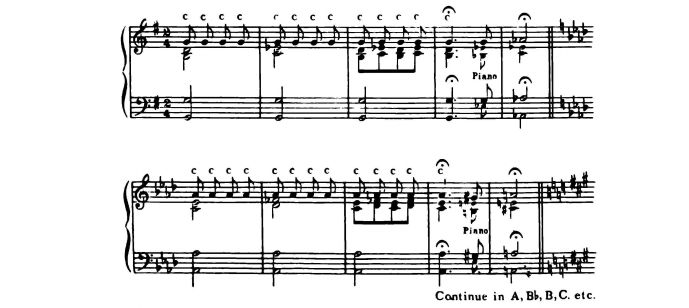
[Listen]
Play the upper notes very distinctly to insure correct intonation of the whistle. The half-step ascent (for piano only) to be clearly played to establish each new tonality; the small chord notes may be used if desired. It is not necessary to continue the upward progressions through the full whistle range; correct intonation being of first importance.
A succession of short chirps (the bird chirp whistled very rapidly and with the grace note a semi-tone above the long note) is produced by a succession of “hews”. Hit each note with this sound and whistle very rapidly. There will be a slight movement of the tongue with each stroke. The chirp is always the “hew” sound. Practice on different pitches.
Keep the lips firm and tense and whistle very rapidly a plain, sharp sound on each note. The same chords which were used for the practice of chirps, may be used for the staccatos, played in the same tempo but whistled as sixteenth notes instead of eighth notes to obtain necessary rapidity, thus:—


The Hewie Chirp is a bird figure comprised of two notes, a given note (with the sound of hew) followed by a grace note above, generally the distance of a third, but may be any interval which will harmonize well with the accompaniment. The Hewie Chirp is one of the familiar figures used continuously by the California Mocking Bird. It is expressed by the character “Hc” and is whistled exactly as it sounds (hew-ie) with a very definite accent on the first note. Keep the jaw and under lip still. There will be a slight movement of the tongue. Whistle “hew”, then slide smoothly to grace note.

[Listen]
Attack the first note with the sound of “hew”, allowing the “ie” to come after very lightly. Be sure also that a decided accent is given to the first note and that the slide is smooth, letting go the grace note very quickly and lightly. Practice “hewie chirps” down the scale and up the scale in different keys.

The “Reverse Chirp” is a bird figure comprised of two notes, a grace note below (having the sound of “hew”) from which a quick slide is made into a longer note above, the distance varying according to the notes in the accompaniment, (as a rule about the distance of a third, fourth, or fifth). The “reverse chirp” is so named because it is the reverse of the “hewie chirp”, the grace note is below and before the note and the accent is on the second note instead of the first note (as in the hewie chirp). The figure is indicated by the character “Rc”.

[Listen]
Attack the grace note with the sound of “hew” and swing quickly and smoothly up into the longer note. The accent on the “reverse chirp” comes on the second note (as indicated). Practice “reverse chirp” down and up the scale in different keys.

[Listen]
Practice this exercise down and up the scale in the different keys. For further explanation and practice of chirps, see page 88.

[Listen]
Practice this exercise ascending also, and in the different keys.
The wave is the regular alternation of two notes (a major or minor second apart) whistled evenly and smoothly. Carry in mind the even undulating waves of the ocean.

[Listen]
The wave is always written “wave” and followed by the wavy line ⁓⁓⁓⁓⁓⁓⁓ when it is to be continued for more than one beat. Be sure to whistle very smoothly, connecting the tones evenly, and do not move the lower lip or jaw. Let the work be done entirely by the tongue and breath.

[Listen]
Practice on different pitches of the scale. Keep jaw still.

The Tongue Trill (indicated by the character “Tr” and followed by the quiver line ⁓⁓⁓⁓⁓⁓⁓) is a figure produced by the twirling of the tongue in the roof of the mouth as though whistling the word “three” or “throw” and making a pronounced roll on the “r”. This takes a great deal of practice to work the tone in with the twirl. At first simply roll (or flutter) the tongue on the rolled “r” (no sound being evident) and then let a plain whistled tone come at the end of the twirl. Gradually the tone and the roll will blend. The tongue, twirling at its tip, is constantly touching the roof of the mouth, but the center of the tongue is drawn down in a dent or groove. Be sure that the front of the tongue is very flexible and loose, and that the lips hold their natural position for whistling (pucker or otherwise) during the entire process.
The Palate Trill is made in the back of the mouth as though gargling. Whistle and make the gargle motion at one and the same time.
The Lip Trill is made by pressure of the breath through the lips as they rapidly buzz or flutter. This trill however is usually made by “tongue and teeth” whistlers (those who do not use the pucker).
Another trill used by some whistlers is produced by inserting the tips of two fingers in the mouth while emitting the tone through the lips. For further treatment of trills, see page 49.
For the development of breadth, i.e., full, round, strong tones, the generous use of legato exercises is necessary. The following should be practiced daily:—

[Listen]
Whistle from the low “C” to the upper “C”, making a decided sweep in the ascent. Hold this last note, making a pronounced crescendo and diminuendo. Practice this exercise on the different note pitches in the scale, for instance from “D flat” to “D flat”; “D” to “D”; “E flat” to “E flat”; “E” to “E”, etc.

[Listen]
Practice daily on different notes of the scale.

[Listen]
Slide very smoothly from one note to the other, connecting evenly. Practice in all of the keys.

[Listen]
Practice this exercise in the keys of “E”, “F”, “G flat”, etc.

[Listen]
Practice this group of notes as high as possible.

[Listen]
Practice this exercise in keys of “B”, “B flat”, etc.
The Quitta is a bird figure used by many birds and is whistled exactly as pronounced. Whistle very rapidly and continuously, quitta, quitta, quitta, etc., keeping as nearly on one pitch as possible.

The single stroke “quit” is also given by the birds and easily whistled,—quit, quit, quit, quit, etc. This is the note of the Flicker.
The Mordent is one of the embellishments used in music and is expressed by the character ⌁. It is comprised of three notes, a principal note, an auxiliary note the next degree higher in the scale, and directly back to the principal note, making the first two notes very quick, and accenting the last one.[1]
[1] NOTE:-There seems to be considerable confusion and some contradictions on the part of the various musical authorities concerning the definition of the term “mordent”.
The form used by Czerny, Hummel and other reputable writers is the one preferred and used by the author, and is a figure expressed by the character “⌁”, composed of a group of notes, the auxiliary note being a major or minor second above the principal note.
The Inverted Mordent, expressed ⍭, has the auxiliary note below.

[Listen]
Treat the two sixteenth notes as grace notes and make a decided accent on the last note (the third note of the group). Do not chirp the attack, (a common fault), nor whistle the middle note too high (also a common fault.)

[Listen]
The Inverted Mordent has the middle note a major or minor second below the principal note, otherwise it is treated exactly like the common mordent explained above.

Practice the mordents down and up the scale in the different keys. Also practice successions of mordents on different pitches. The following arrangement (the mordent represented by notation and by sign, and with piano chords) may be an aid.

[Listen]
The chirped mordent “c⌁” (“hew” attack) is often used in bird figures.
The triplet is a group of three notes (or their equivalent) whistled in the time of two notes of the same kind. Make the notes even, accenting the first one, and whistle smoothly from one note to the other. However, do not connect the groups. Be careful to accent definitely the first note, in order not to confuse this figure with the mordent.

[Listen]
There are many arrangements of the triplet, but the one written above is the common one used in whistling. Practice down and up the scale in the different keys. Also practice the triplets staccato, thus:—

[Listen]
The triplet is generally expressed by the figure “3” above or below a group of notes. In whistling, the figure is often used over a single note which indicates that three notes are to be given, and usually arranged with the middle note a major or minor second above the first note. If a special arrangement is desired, the notes are written out in full.

[Listen]

[Listen]
Make the triplets smooth, and accent decidedly the note following each group. Close the exercise with a sweep from the low note up an octave and back to the original note. Practice this exercise in different keys.
[2] The character ⌃ placed above a note indicates a plain whistled note; when combined with a whistling symbol, it indicates a staccato note.

[Listen]
Practice this exercise not only smooth (as written), but also staccato, thus:—

[Listen]
Make the staccato notes bright and crisp. Practice this exercise in different keys.
The triple-tonguing is a figure made by whistling three short, sharp sounds on one note. In reality it is a staccato triplet. The term is applied to a combination tongue stroke used by flute and cornet players. As applied to whistling, it is a misnomer, as the tongue lies absolutely still in the lower part of the mouth near the lower teeth. Keep the lips (particularly the lower one) firmly tensed. The tones are produced entirely by the breath.

[Listen]
For practice, whistle this exercise down and up the scale in the different keys. Also practice successions on different pitches.

[Listen]

[Listen]
Whistle smoothly the ascending scale, then chirp each note in the descending scale. Practice in the various keys, i.e.—D♭; D; E♭, E; F, etc.

[Listen]
Whistle first note staccato, following with a chirped note, and so on; alternating throughout the entire exercise. Practice in the various keys.

[Listen]
Attack the first note with the sound of “hew”, swinging smoothly to next two notes. Again attack with “hew” sound and continue as before. Swell on last note. Practice in the various keys, ascending only.

[Listen]
Connect first two notes; whistle a reverse chirp from “e” to “g”; the hewie chirp from “b” to “d”; another reverse chirp from “d” to “f”, and slide smoothly to the following notes. Hold last note and swell.

[Listen]
Whistle the short chirps on the notes designated, making the reverse chirp from “g” to “c”, and hold two counts. Whistle the first hewie chirp “b” to “d”, the second one “g” to “b”; the reverse chirps having the attacks from a third below in each case; and then slide to last note, and hold. Practice in the various keys, i.e.:—D♭; D; E♭; E; F, etc.

[Listen]
Keep the time even; four short chirps on first beat; and eight staccato notes on second beat. End with a plain note. Practice in the various keys, both descending and ascending.

[Listen]
Whistle the two reverse chirps (“g” to“c”) on first beat; the three short staccato notes and the plain note on the second beat; two more reverse chirps (“e” to “g”), and whistle staccato notes as before; two more reverse chirps “d” to “f”, and finish as before. End with mordent on half note. Practice in the various keys, descending only.[3]

[Listen]
Mordent the first note, and glide to the staccato note following. Practice in the various keys, descending and ascending.

[Listen]
Mordent the first note, following with a hewie chirp the interval of a third. Repeat idea throughout exercise. Practice in the various keys, descending and also ascending.

[Listen]
Practice in the different keys, ascending only.

[Listen]
Practice in the different keys, ascending only.

[Listen]
Practice in the different keys, ascending only.

[Listen]

[Listen]

[Listen]
Whistle a smooth triplet on the first beat; two short chirps on the second beat; a quick “hewie chirp” on the third beat; and close the exercise with a mordent on the last note. Practice descending only.

[Listen]
Whistle a quick “hewie chirp” on the first beat; a short chirp on the second beat; a plain note on the third beat; a mordent on the fourth beat; a smooth triplet on the fifth beat; and again another plain note on the sixth beat. Continue this arrangement throughout the entire exercise. Close with a mordent on the last note. Practice down and up the scale in the different keys.
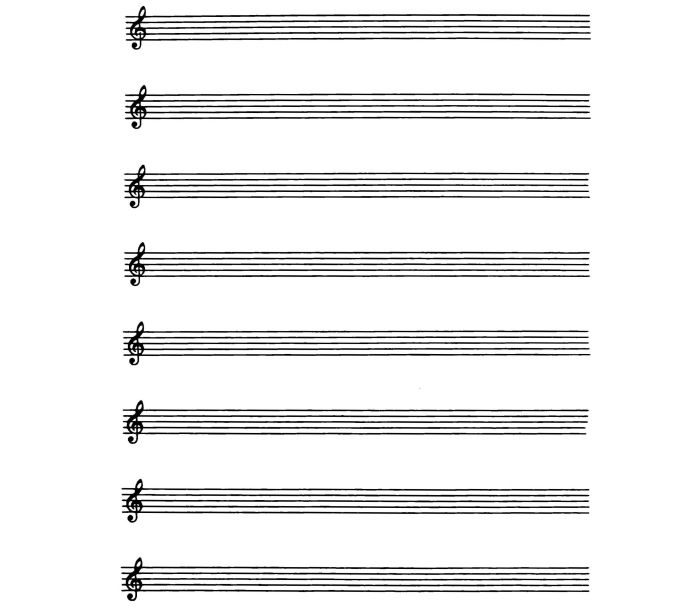
The “whip” is a brilliant, dashing, upward stroke, and may be likened to the lashing of a whip (hence its name); or to the sound used to call a dog, hail a car, or get the attention of a passerby.

Whips are used invariably on high notes, and very commonly close a selection which is designed to end brilliantly. The heavy and pronounced accent of this figure comes on the last note, the start being on a harmony note below (generally the nearest the principal note).
The following chords may be used in the practice of this figure.

[Listen]
The “Upward Cry” is a gliding, ascending stroke which feathers out daintily about an octave above. The heavy accent comes on the attack and the sound grows fainter as it ascends. This figure is applied generally to notes of medium or low pitch, occasionally to high notes.


[Listen]
Be sure to attack each note directly on the given pitch, and glide out and up smoothly, feathering out an octave above very daintily. Occasionally the “upward cry” is used without a definitely indicated pitch, in which case the figure starts from any note in medium register.
The “Downward Cry” is a gliding, descending stroke which feathers out daintily at the end. It is the reverse of the “upward cry”, starting on a high note and feathering off daintily about a fifth below. The effect of the “downward cry” is always pathetic.
As a rule the “downward cry” starts high, (no definite pitch indicated), and is written above the staff, thus:—

The plaintive cry of a bird with a broken wing is the identical sound, and conveys the idea clearly. About the distance of a fifth is covered, for instance from high “G” down to “C” (3rd space).
If, however, a cry starting from a given pitch is desired, whistle the note and from it glide smoothly downward, thus:—


Be sure to accent definitely the attack of the “downward cry”, the pitch note.

[Listen]
Accent definitely each attack and follow down and up the scale as indicated.
A succession of “upward and downward cries” when written with symbols will appear thus:—

N. B. When definite pitch is desired, symbols begin at note heads.
The “Whit-cha” (call of the Red Bird and also a familiar figure used by the California Mocking-Bird) is a combination of a whip and a chirp. When analyzed the figure will have the sound of “whee-hew” the “whee” ascending, and the “hew” descending. The chirp sound is always “hew”. However, this name “whit-cha” was given to the figure as being the sound nearest that made by the birds. Do not be too literal and have the “cha” sound like “chew”. Remember this is a chirp and should be simply “hew”. Let go quickly of the “whee” keeping the tongue (the tip) against the teeth, and the lips in their natural pucker. There should be no breathiness in connection with the tone.
“Whit-cha” could also be written thus:— / c

[Listen]
The following diagrams may aid:—

Diagram 3 shows accent on “ee” and on the last “oo”. The two syllables, although whistled rapidly, are not connected. The “whit-cha” is used in many combinations, for instance the syllable “koo” is sometimes added, thus:— “whit-cha-koo”. In notes it would appear thus:—

[Listen]
“Whit-cha” is always written as an ascending figure, thus:—

But by analysis would appear thus:—

The figure is sometimes reversed, in which case it is called “cha-whit” and is a combination of a “chirp” and a “whip”. It is whistled “hew-whit”, the first stroke being a downward stroke, and the second an upward stroke.
It is also written as an ascending figure, thus:—

This figure is the combination of a staccato note and a chirp, and is rather similar to the “whit-cha”, with the exception of the start. It begins with a staccato note high, (instead of the “whip”,) and the chirp is usually lower than in the “whit-cha”. The letter “c” is entirely eliminated in the word. Simply whistle “e-hew”. It is a descending figure and is written thus:—

[Listen]
A succession of “e-(c) hews” would appear thus:—

The “Quitchaquia” is a bird figure whistled exactly as pronounced. Make a decided accent on the “qui”, and a little drop at the end of the word. By analysis this figure would be pronounced “Quit-hew-qui-ah”, the “quit”, ascending, the “hew” descending, the “qui” ascending, and the “ah” descending. The syllables are all joined and whistled rapidly. The following diagram may aid:—


[Listen]
This exercise gives the practice of a smooth triplet with a chirped attack, reverse chirps and staccato notes. Be sure to attack the triplet with a chirp (“hew” sound), and glide smoothly to the following note, letting go very quickly. Whistle “reverse chirps” as indicated, and in last measure, jump from the staccato note to the final note. Practice this exercise in different keys.
After having mastered the foregoing lessons, the student at this point may take up as studies the selections “Moon Winks” and “Mother Machree” on pages 77, 79.
The yodel is a figure expressed by circles thus: ooooooooo and is made by the action of the tongue in the roof of the mouth while rapidly whistling the word “oodle”. The words “loodle”, “doodle” or “laddle” may also be used as a help in acquiring this liquid tone. On the higher notes the action is nearer the upper teeth, about midway on the ridge, and on the lower notes more in the roof of the mouth. This is one of the most attractive figures in whistling and is the basis for several other strokes. In the making of the yodel the tip of the tongue is rapidly touching the roof of the mouth near the ridge while a decided downward pull is felt at the base of the tongue, as though forming a cavity in the rear of the mouth.
YODEL PRACTICE

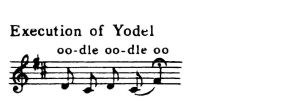
Whistle the first syllable “oo” on the pitch of “d” and the “dle” on the semi-tone below. Repeat this in a similar manner and then swing smoothly from the last syllable (the semi-tone below) into the note a third above, making this a plain note, the sound of “oo”. At first do not attempt the higher pitches, but devote more time to these first three groups. Practice also four “oodles” and ascend on the fifth to the plain “oo”.[4]
When done rapidly and blended, the yodel gives the effect of two notes whistled at the same time. For spiral yodels see Lesson VI.
[4] It may be stated here that low and medium tones have the sound “oo”, while high tones have the sound of “ee”.
The “hedala” is a Mocking Bird figure whistled exactly as pronounced. The “he” is a plain, high tone, the “da” is a medium tone struck in the roof of the mouth near the teeth, falling back quickly into position and turning up again on the syllable “la”. Accent the “he” and turn quickly into the “da” and again from the “da” into “la”. This is one of the descending bird figures and is written thus:—

[Listen]
The “cudalee” is also a Mocking Bird figure, whistled as pronounced, the attack having the sound of “K”. It is an ascending figure and is written thus:—

[Listen]
Alternate “hedala” and “cudalee”, thus:—

The “Lup” is a bird note made by striking the tongue quickly against the roof of the mouth as though saying “luh” or “la”. The figure is called “lup” because of the sharp click which accompanies the stroke. However, the letter “p” is entirely eliminated when whistling. Think only of the word “luh”. Whistle quickly this word and immediately let the tongue drop back into its normal position in the lower part of the mouth near the teeth, preparing for another stroke.
No word in the English language containing an “l” is ever articulated without this little stroke of the tongue in the roof of the mouth (on the ridge back of the teeth). For instance, try the words, love, like, life, land, load, loop, etc., and note the position of the tongue.

[Listen]
Practice similar groups in different keys
A succession of “lups” as written and expressed in whistling, would appear thus:— ℓ ℓ ℓ ℓ ℓ ℓ ℓ ℓ ℓ ℓ ℓ ℓ ℓ ℓ ℓ
Practice on different pitches of scale, thus:—

[Listen]
The “lup-ee” is a figure comprised of the “ℓ” stroke (lup) followed by a staccato note a third higher. Whistle simply “luh” and follow it with the “ee” a third higher. Make the stroke on “luh” very short and sharp, and do not connect between this and the staccato note. The character ⌃ is used to indicate a plain whistled tone, and may be either short or long, according to its use.
A succession of “lup-ees” as written and expressed in whistling would appear thus:— ℓ⌃ ℓ⌃ ℓ⌃ ℓ⌃ ℓ⌃ ℓ⌃ ℓ⌃ ℓ⌃ ℓ⌃ ℓ⌃ ℓ⌃ ℓ⌃
Practice on different pitches of the scale, thus:— Execution


The “lup-ee” is occasionally used on intervals other than a third.

[Listen]
Practice this exercise in different keys. Accent definitely the first note.
The “E-lup” is a figure composed of a staccato note and a “lup”, the staccato note above, and the “lup” (a grace note) a third below.


Practice this exercise in the different keys. Accent definitely the staccato note and lightly touch the “luh” on the grace note.
The “Lah-ee” is a bird figure comprised of a “lup” and an “upward cry” (which ascends out of it). Whistle the sound of “luh”, holding it and smoothly gliding up with the “upward cry”, feathering off at the end very daintily. Do not hold.

[Listen]
Practice down and up the scale in the different keys.
The “Lah-ee” is often indicated by the “lup” and cry combined, thus ℓ◞
A succession of “lah-ees” expressed without notes would appear thus ℓ◞ ℓ◞ ℓ◞
The “Lee-ah” is a bird figure comprised of a “lup” and a downward cry. It is made by whistling the sound of “luh”, holding it and then letting the “downward cry” glide smoothly from it. The symbols are often combined thus ℓ◝
A succession of “lee-ahs” expressed without notes would appear thus ℓ◝ ℓ◝ ℓ◝

[Listen]
Practice down and up the scale in the different keys.
The “Chut-ee” is a bird figure comprised of a chirp and a staccato note. It is made by whistling a chirp (hew sound) on a given note, following it with a staccato note a third higher. This is simply a name given to this combination to distinguish it from the “hewie chirp”. Make a decided accent on the first note (the chirped note), and follow with the staccato note a third higher. Do not connect the two. If connected, this figure would be “hewie”. Let go the grace note lightly.

[Listen]
Practice down and up the scale in the different keys.
“Chut-oo” (c⌃) is occasionally used, and whistled thus:—

A succession of “chut-ees” as written and expressed in whistling would appear thus:— c⌃ c⌃ c⌃ c⌃ c⌃ c⌃ c⌃
Practice on different pitches of the scale, thus:—


For practice, alternate “chutee” with “lup-ee”, thus;—

[Listen]
Practice down and up the scale in many different keys. Continue as far as the range of the whistle permits.
A piano accompaniment which may be used for the practice of successions of “chut-ees” (c⌃); “lup-ees” (ℓ⌃) or “thrup-ees” (thr⌃) is given below.

[Listen]
Disconnect entirely between the first note (the tongue stroke) and the second note (the staccato note). Practice successions on different pitches of the scale.
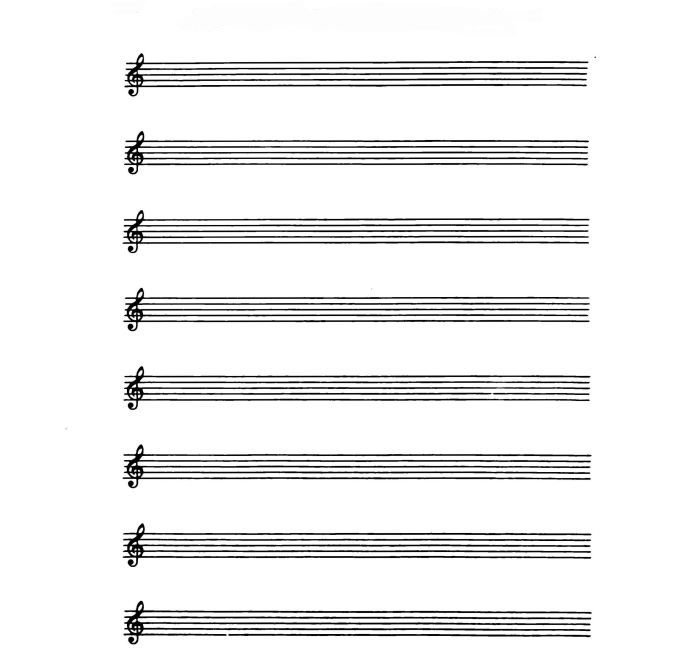

[Listen]
Practice this staccato exercise in connection with the “yodel” and “lup” work, and for general development, as it will focus the tone forward and give brilliancy to the quality. The tendency of the whistle in yodeling is to drop back in the mouth, and the staccato work will bring it forward again. Practice in the different keys, ascending only.
This is a simple stroke made by whistling the word “koo”

[Listen]
Whistle the grace note with the sound of “K” as in the word “koo”, and jump immediately to the staccato note a third higher. Do not connect the notes. Accent decidedly the second note.
Practice ascending and descending in the different keys.

[Listen]
Practice this exercise in several keys, ascending only.
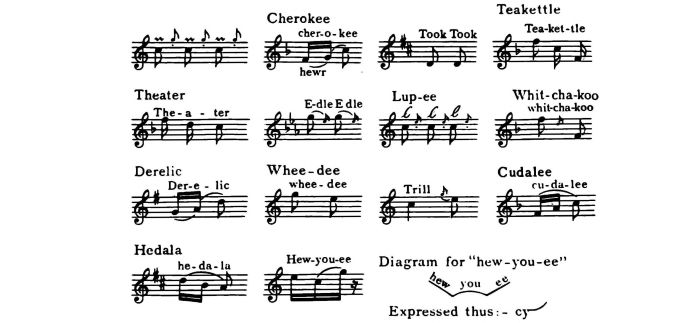

Whistle the “oodle” sound very rapidly in the roof of the mouth, blending the tone as smoothly as possible. In the ascending yodel the action of the tongue begins at the back of the mouth (in the roof) and works along the roof towards the front teeth. As it nears the front where it is impossible to use the “oodle” sound any higher in pitch, the tongue drops back into normal position (to the lower part of the mouth) and an “upward cry” feathers out delicately. In the descending yodel, the position is reversed. The tongue starts with a high plain tone produced in the usual way (the tip lying easily against the inside of the lower teeth, high up) and then as quickly as possible, strike a “lup” in the roof of the mouth and follow immediately with the “oodles” as described before, allowing the tongue to work along the roof to the back, at which time there will be cessation of tone. The descending yodel may also start with a short “downward cry”.

[Listen]
This is a good exercise for general work and should be practiced daily. Take in several different keys, (ascending only). In connection with the yodel practice, it is especially advantageous for focusing the tone forward. If the key of “D” is too low, start with key of “F”. Note that the triplets used are staccato triplets.

In “dipped yodels” (a combination of the descending and ascending yodels) use exactly the same principle as though whistling each separately, only make continuous liquid “oodles”, starting moderately high in pitch, quickly descending and quickly continuing up again, feathering off at the end with an “upward cry”.
Note that the minute the tongue ceases to be used in the yodel sound, it drops back to its normal position in the lower part of the mouth near the front teeth. As a help in starting the “dipped yodel”, think of the word “hedala”.

[Listen]
In this exercise strike the staccato note as indicated, then jump a third lower and whistle a sharp “lup” (luh). Again strike a staccato note (as indicated), and “yodel” up into the following note, starting the “yodel” about a fifth below and roll directly to the given pitch. Practice this exercise in several different keys.

[Listen]
Whistle a sharp “lup” (luh) on the first note and follow this with a bright staccato a third higher. Again whistle on the pitch of the grace note a sharp staccato note, and drop to a “lup” (luh) on the grace note a third below. Continue this idea down the scale, and practice in the different keys. Take also ascending. The “lup-ee” “e-lup” when expressed by characters will appear thus:— ℓ⌃ ⌃ℓ ℓ⌃ ⌃ℓ ℓ⌃ ⌃ℓ
Close the exercise with a mordent on the last note.
Practice of the following will aid to focus the tone forward on the lips when it has receded in the mouth during practice of “lups” and “yodels”.
(See also staccato exercises on p. 46)

[Listen]

[Listen]

[Listen]
Continue this exercise (begin a half step higher each time) as far as the range of the whistle will permit. Also practice with “chirps” and “lups”, thus:—

[Listen]
Practice the chromatic scales also ascending.
For certain bird effects, a chirp may be used in the initial attack on the following symbols:—
wave (⁓⁓⁓⁓⁓⁓⁓); mordent (⌁); upward cry (◞); downward cry (◝); thus:— c⁓⁓⁓⁓⁓⁓⁓ c⌁ c◞ c◝

[Listen]
Illustration of the chirped mordent:—
The sign (⦣) is used to indicate an accent.
The “upward cry” may be affixed to the following:— chirp (c); reverse chirp (Rc); mordent (⌁); trill stroke (Thr); lup (ℓ); and hedala, thus:—
c◞ R◞ ⌁◞ Thr◞ ℓ◞ hedala◞

Illustration of chirp with upward cry:—
Attack with sound of “hew”, and glide upward about the distance of a fifth or an octave.
The “downward cry” may be affixed to the following:— chirp (c); reverse chirp (Rc); mordent (⌁); trill stroke (Thr); lup (ℓ); and cudalee, thus:—
c◝ Rc◝ Thr◝ ℓ◝ cudalee◝

Illustration of chirp with downward cry:—
Attack with sound of “hew”, and glide downward about the distance of a fifth.
The bird figures “quitchaqúia” (whistled “quit-hew-qúi-a”,)and “quiaqúitcha” (whistled “qui-a-quit-hew”) both have a decided drop at the end of each figure. On the first figure the drop is on “a”; and on the second figure the drop is on “cha” (whistled “hew”).
The marcato sign ⌃ may be used following the chirp (c); the reverse chirp (Rc); mordent (⌁); triplet (3); trill stroke (Thr); triple tonguing (· · ·); lup (ℓ); short yodel (ooo); Koo (K); and hedala;—thus:—
c⌃ (called “chut-ee”); Rc⌃; ⌁⌃; 3⌃; Thr⌃ (called “thrup-ee”); · · ·⌃; ℓ⌃ (called “lup-ee”); oooo⌃, K⌃; and hedala⌃.
In such combinations the marcato sign ⌃ indicates a staccato note. It is placed above and following the symbol, usually the distance of a third, fourth, fifth, or any interval which will harmonize with the accompaniment, and is always short.

Illustration using the mordent:—
The marcato sign ⌃ may be placed also below the symbol, the distance of a third, fourth, fifth, or any interval which will harmonize with the accompaniment, and is always short.

Illustration using the chirp:
For acquiring flexibility of tongue, the following groupings of bird figures may be used:

Thr⌃ ℓ⌃ c⌃ ◝ Illustration:—
The following whistled rapidly will also aid:—

Hc c ⌃ ℓ◝ quia◝ Illustration:—

[Listen]
Whistle a staccato triplet (as indicated), then a plain note in the next measure, treating the two sixteenth notes as grace notes, attacking with a chirp and connecting all three notes. The plain note comprises the first beat, the chirped group the second beat, the staccato grace note with the staccato eighth note, the third beat, and the last staccato grace note with the last staccato eighth note, the fourth beat. In last measure whistle again another chirped group (as explained in the preceding measure). This closes the exercise. Practice in the different keys.

[Listen]
Attack the “hewie chirp” with definite accent (this makes the first beat); then follow with two short “lups” on the pitches written, (this makes the second beat); and follow with a “whi-cha whee” on the third beat, making the “whit-cha” on the pitches of “E” and slide from the “cha” (hew) to the “whee” (a plain tone) on the second line. From this last note swing down smoothly to the “C” in the last measure. Practice this exercise in different keys. Watch carefully that the “whitcha” made on the same pitches does not become breathy or muffled.

[Listen]
This exercise, for the practice of downward and upward strokes is one of the best.
Make the chirps bright and crisp and exactly on the given pitches. Make also the “whips” bright, and follow the pitches accurately. “Whips” on low notes are hard to execute. On this lower group think of the word “whee”. Keep tip of tongue against lower teeth, (inside). When the quick stroke is made, the back of the tongue raises somewhat, and there is a very perceptible motion at the point. This is an unfailing rule in the making of the “whip”! Practice this exercise in several different keys.
A few combination figures used in interpolative work


[Listen]
Glide very smoothly from the low note to the octave above, and back again. Then hit the staccato grace note lightly and jump to the last note. Continue as far as the range of the whistle will permit. When whistling from the lower to the upper note, attack softly, making a broad sweep to the upper note, which receives the greatest volume.

[Listen]
Take quickly and smoothly the three notes comprising the first group, down and back again, and let go of the last note lightly. Now hit with a chirp (“hew” sound) the low “C”, and glide up the octave, letting go the upper note also lightly, (this last figure being in reality a “hewie chirp”). Continue as far as the range of the whistle will permit.

[Listen]
Whistle accurately these octave jumps, and make the staccato notes clear and sharp. Continue as far as the range of the whistle will permit.

[Listen]
Make a quick “reverse chirp” on the upper note, observing the rest, and then whistle a quick mordent on the lower note. Continue as far as the range of the whistle will permit.

[Listen]
Make two even staccato eighth notes on one beat, and a “hewie chirp” on the second beat. Repeat the figure an octave lower, and watch carefully that the pitches are accurate. Continue as far as the range of the whistle will permit.

[Listen]
Whistle smoothly from the first note to the eighth note, letting go at once. Whistle a chirp (“hew” sound) on the following grace note and swing from it to the longer note on “E”, and from that up to the next eighth note on “C”, letting go of this immediately. Again take a chirp on the grace note (“C”), swinging down smoothly to “G” (second line), on up evenly to “E” (fourth space), and let go of this note at once. Again strike the pitch of “E”, holding two full counts. In the following measure descend on the staccato notes as written. Practice this exercise in different keys.
The “Thrup-ee” is a bird figure comprised of a short trill stroke followed by a staccato note usually about a third higher.

[Listen]
Roll the tongue quickly on the “Thr”, and jump at once to the staccato note, letting this be light and dainty. End with a single “Thrup”. Practice this exercise in the different keys, down the scale and up the scale.
“Thrup-ee” when placed above a single note, or introduced into interpolative bird work, is indicated thus:— “Thr⌃”
The “E-thrup” is a bird figure comprised of a staccato note followed by a short trill stroke usually about a third lower.

[Listen]
Strike the staccato note sharply but definitely, and jump at once to the “Thrup”. Practice in the different keys down and up the scale. When ascending whistle thus:—

[Listen]
and stop on E♭ (fourth space).
“E-thrup” when placed above a single note, or introduced into interpolative bird work, is indicated thus:— “⌃Thr” which means that a short note is to be whistled in advance of the trill stroke (Thrup).

[Listen]
Notice in this exercise (contrary to the general rule) that the staccato note preceding the “thrup” is a very short note and that the accent comes definitely on the second note (the “thrup”).
Make the sixteenth notes short and bright, and jump at once to the “thrup” notes. Then in the following measure, whistle the “K’s” in thirds up the scale (thinking of the word “koo”), and end on a plain note. Notice that these are all even sixteenth notes, and not connected. Whistle “K” on the first note and immediately jump to the staccato note which follows it. Practice in several other keys.

[Listen]
The “Ascending Quiver” is a combination of a vibrated tone and an ascending staccato chromatic scale (done very rapidly), feathering out with an “upward cry” at the end. Begin low (or if a definite pitch is indicated, take directly from this pitch) and rapidly carry the gentle, indefinite staccatos upward, and feather off sweetly in an “upward cry”.
Deal in similar manner with the “Downward Quiver”, only reverse the figure, and carry in mind the whinny of a horse, or the trickling of water over pebbles.
The Turn is an embellishment expressed by the character ∾ and consists of a principal tone with two auxiliary tones, usually those respectively a step above and a half step below, thus:—

[Listen]
An accidental placed above the Turn affects the upper auxiliary note, and when placed below, it affects the lower one, thus:—

[Listen]

[Listen]

[Listen]
Practice this exercise in several different keys.

[Listen]
This exercise gives the practice of “whips”, a mordent followed by quick staccato notes, “hewie chirps”, a single “chirp”, a staccato note, and a plain note.
Make the “whips” brilliant, one on each of the three beats (pitches “C” to “E”), the fourth beat being a rest. In the next measure make a mordent on “G”, and follow with staccato notes on the exact pitches. In the next measure, make the “hewie chirps” on the pitches written, accenting definitely the attack of “hew” on the first of the figure, and close the measure with a single “chirp” held two counts. End the exercise with a staccato note on “D” and a jump to the last note. Practice this exercise in several different keys, ascending only.

[Listen]
Slide smoothly where curved lines indicate (this gives breadth to the whistle), and hold the notes indicated. Take up the staccato notes quickly and make clear and distinct. Practice in the keys of D flat, D, E flat, E, and F, or as far as the range of the whistle will permit.
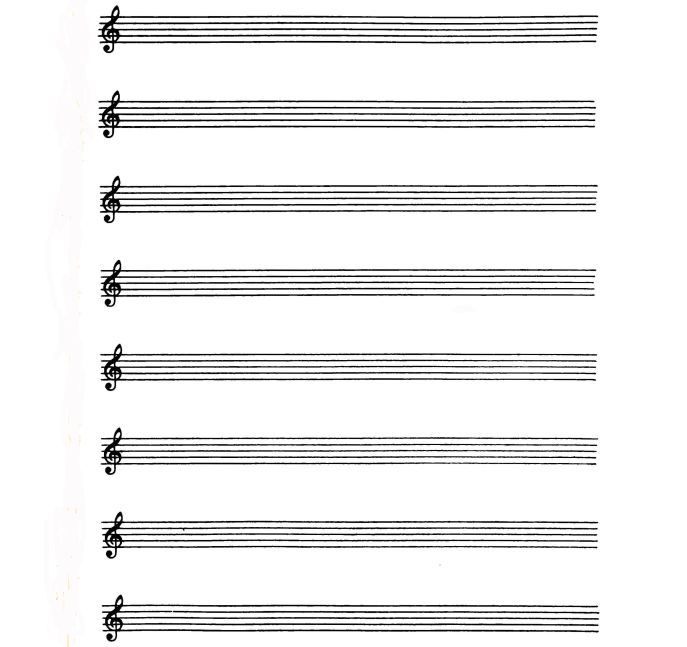
————
In the making of an ordinary bird chirp (c) whistle the “hew” sound directly on the note, and do not make a “chug”, “chew” “cha” or “hew” sound preceding the note.



[Listen]
Whistle two short sharp chirps on the pitch of “C”, and follow with two staccato notes a third higher. Note that a chirp occurs directly after the staccato notes, and in order to make this as perfect as the first two, a quick downward stroke of the tongue will of necessity be required. Think of this figure in syllables thus;—“hew, hew, ě, ě, hew”.

[Listen]
In this exercise, the “chirp” occurs on the grace note, after which a jump is made to the following note (the 16th note). Whistle lightly from note to note. Do not connect.

[Listen]
Accent definitely and decidedly the “hew” in the “hewie”. The “downward cry” starts from the quarter note. Whistle thus:—

[Listen]
Watch carefully in the making of the “hewie chirp” that the sound of “hew” is always given the first note, also that the syllable comes directly on the note and not before it.



[Listen]

[Listen]
Treat the “Hewie chirps” as previously explained, and make the next three notes staccato. Note that the “hew” has one full count. Accent definitely this count, and in the notes following whistle the first two quicker than the last. Practice in different keys.


[Listen]
Attack the “reverse chirp” with the “hew” sound on the grace note, and quickly glide to the upper note. The accent on the “reverse chirp” is always on the second note. The explanation of “E-chew” has already been given in the fore part of the book. Close the exercise with a mordent on the last note. Practice in several different keys.

Make the “reverse chirp” as previously explained, holding the second note and from it gliding smoothly up a third, letting go lightly. Close the exercise with a single “reverse”. Practice in different keys and take both descending and ascending. The reverse chirp may also be combined with a downward glide (Rc); and whistled “hew-ee-ah”.

[Listen]
Whistle the four short chirps on the first beat of the measure, and the “hewie chirp” and the “reverse chirp” on the second beat. Be sure, however, that a decided accent is given the first note of the “hewie chirp” and an equally prominent accent to the last note of the “reverse chirp”. Close the exercise with a mordent on the last note. Practice in several different keys.
Watch carefully that in the making of the “hewie” and “reverse” the two notes comprising each figure are smoothly connected.
The “Lup” (“L” stroke) has been previously defined, but a more detailed explanation may not come amiss at this time.
In whistling the “lup” (“luh”) strike the tongue sharply on the ridge back of the upper teeth, keeping constantly in mind the word “loo” or “luh”. Do not allow any whistling sound to escape before the stroke. For example, do not whistle “ah-luh” or “oo-loo” but simply “luh”, and whistle it quickly and sharply. The upper side of the tongue near the tip is the portion employed for the stroke, and touches the upper part of the mouth on the ridge near the teeth when high notes are whistled, and farther back on the roof (more in the dome of the mouth) when the lower notes are taken.
Shape the lips for whistling (in their natural pucker) before attempting a sound, then quickly throw the tongue against the roof (as before described), and whistle the note simultaneously with the “luh” stroke.
The following exercises may be helpful for daily practice.

[Listen]
Make the “e-chew” sharp and not connected. This forms the first beat. The “lups” (four 16th notes) complete the measure on the second beat. In the last measure whistle the “lup” and allow the “upward cry” to ascend from it, this entire figure forming the first beat of the second measure; the second beat being silent. Practice this exercise in several different keys.

[Listen]
Practice this exercise in all of the keys. Also reverse the figure putting the staccato note first and follow with the “lup”, and practice in like manner down and up the scale.

[Listen]
Practice this exercise in similar manner as described above.

[Listen]
Practice down and up the scale in the different keys.

[Listen]
Practice in similar manner as above.

[Listen]
Practice in similar manner as above.

[Listen]
Practice this exercise down and up the scale in the different keys. Also alternate with chirps, thus:—

[Listen]

[Listen]
Whistle each “lup” sharp, short and distinct. End each group with a mordent. Practice in a few other keys, and take both ascending and descending.

[Listen]
Strike the first two “lups” with decision and sharpness, and immediately from the third “lup” swing into the yodel. In reality it begins the yodel. Practice on different notes in the scale.
General practice of the “hedala” with various exercises
The “hedala” should always be made rapidly, thus “hée-dle-la” accenting definitely the “he”. This, although a Mocking Bird figure, is also the liquid tone used in the Meadow-lark’s song.

[Listen]
Watch carefully the pitches. Make the “hedalas” on the pitches indicated, also the two high staccatos on “G”. Do not whip the staccatos (a common fault). The “whitcha” should also be made on the exact pitches indicated, the “whip” on “E” and the “chirp” (hew) on “G”. Slide up smoothly an octave, from low “C” to upper “C”, and hold two counts. Practice this exercise as far as the range of the whistle will permit.

[Listen]

[Listen]
In whistling these “hedalas” accent definitely the first syllable, starting the figure from the pitch of “E flat”, and continue down the scale, lowering the pitches on the descent. Then take up the “chirps” quickly and brightly and ascend from low “E flat” (which begins the chirped ascent) and climb quickly the chromatic scale to the final “E flat” in the last space. This exercise may be taken in one or two keys higher, possibly up to “G” (key of one sharp).
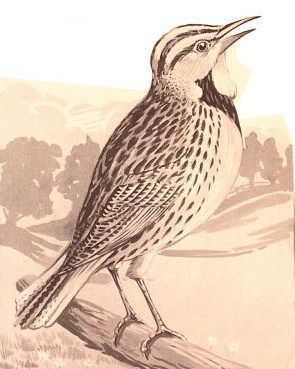
THE MEADOW LARK
The bird that gives the many beautiful liquid notes which are used in the Woodward Method of Bird Whistling.
(Reprinted by permission of the Whitman Publishing Co., Racine Wis.)

[Listen]
Watch carefully that all pitches are accurate, and that the distance between the chirp and staccato is always a third. End with mordent on last note. Practice in two or three different keys.
Although the “hedala” is written above the note, it should start, as before stated, from the note and be whistled down from this given pitch.

[Listen]

[Listen]
This song is one of the most beautiful and most difficult to reproduce, and calls for great flexibility of tongue and persistency in practice.
Make the introductory notes marked, (accented though not staccato), then follow with the yodel in double dipped effect, going back again as though two “hedalas” were used, the one connected to the other, thus:—

Note that there is a decided dip to the yodel which ends with an abrupt “Lup”. This figure varies somewhat, particularly at the beginning. Some songsters begin with a short, sharp staccato note and follow with one marcato note, dropping quickly to a lower note and then back to a high note from which the liquid yodel as described before, is used, thus:—

[Listen]
(A help for the Meadow-lark’s Song)
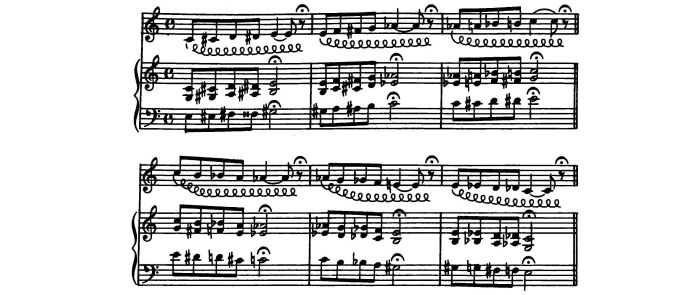
[Listen]
Yodel continuously (possibly five “oodles” on a note), and continue the liquid warbling on the notes held. Take ascending as indicated, and descend in similar manner.

[Listen]
Whistle four sharp “lups”, and from the fourth one, yodel up quickly the distance of an octave, letting go immediately.

Begin the yodel with the tip of the tongue at the rear of the mouth (upper part), and work along the roof as previously explained. Keep the motion and sound continuous, without a break at any point, both ascending and descending. Cover about the distance of an octave.
California Grosbeak:—

[Listen]
California Grosbeak:—
(A different song)—(wa-tee; edle-lup)

[Listen]
Whippoorwill call (Eastern):—

[Listen]
Whippoorwill call (California):—

[Listen]
The Oriole:—

[Listen]
The Bob-o-link:—

[Listen]
The following songs are indicated by syllables only.
The Thrush:—qui, qui, quila, quila, quila.
The Bluebird:—tru-al-ly; tru-al-ly; tru-al-ly.
The Red-winged Blackbird:—Ke-kong, ker-ee; o-ka-lee.
The Lark:—Fere lire, ly-ly; pity fire li.
The Nightingale:—ah, ah, ah; wati, wati, wati; quoi, quoi, quoi; ur-tee-ol; quit, quit quit, quit; trill ⁓⁓⁓⁓⁓⁓⁓ ah, ah, ah , ah, cc cc cc ur-tee-ol.
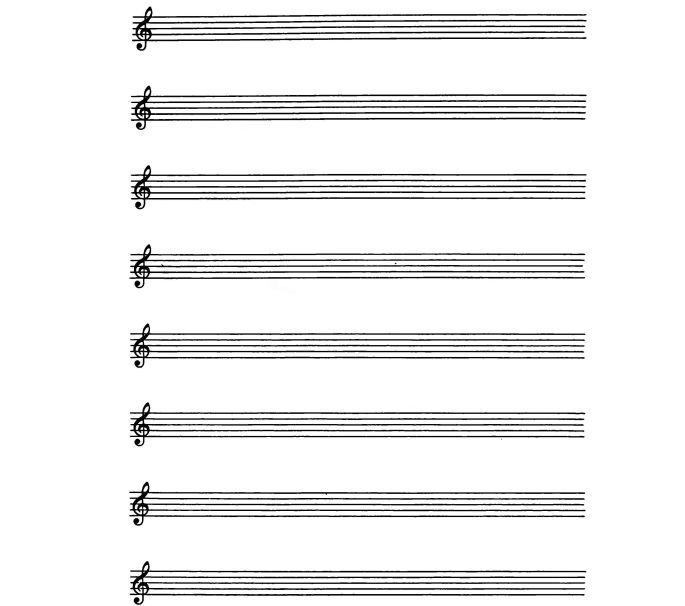
This is one of the most difficult figures in whistling and is equally difficult to make plain to a student without personal demonstration.
The tongue at the front should be loose and flexible. As to its position, a word picture may help. Think of an ordinary orange spoon, grooved in the center and pointed at the end.
The first step to be taken is to determine whether or not a vocal sound can be formulated while the tongue is “twirling”. This is a sound often used by school girls in calling each other, and has a decided rising inflection. If this is possible of execution, then omit the vocal sound but continue the twirling. The next step to be taken is the same action of the tongue through puckered lips, the natural pursing of the lips for whistling. Again twirl the tongue (with the lips properly puckered) and allow a plain whistled tone to be emitted at the close of the twirling, thus:—

For further practice, whistle the plain note first and then commence the twirling by allowing the tongue to force itself from its position in the lower part of the mouth into the open cavity, and continue the action as long as possible, ending with a plain note, thus:—

This is much more difficult of execution. Think of the following:—
| - | ⁓⁓⁓ | - | ⁓⁓⁓ | - | ⁓⁓⁓ | - | ⁓ | - | - | ⁓ | - |
| e | three | e | three | e | three or | e | tr | e | e | tr | e |
If the muscle under the tongue is very short, this trill will be impossible to accomplish. However, the palate trill may be substituted, and will serve all purposes. In this trill, think constantly of gargling. There is no better illustration. Whistle and use the gargling motion at the same time.
Another trill used by some whistlers is the “in-breath” trill, produced by the motion of the palate during the intake of breath.
The “lip trill” is another brilliant warble produced through the buzzing of the lips, used mostly by “tongue and teeth” whistlers.
Still another trill is the “saliva trill”, but as this depends entirely upon an ample quantity of moisture, it is never dependable, especially should the whistler be nervous and in consequence have a dry mouth.
There is also a trill employed by some whistlers which is produced by inserting the tips of two fingers between the lips while the tone is being emitted.

[Listen]
Make the first note staccato. Then whistle a quick “thrup” (trill stroke) on the note a third below. Follow this on the second beat with two “E-thrups” (16th notes) and make them very fast. This is excellent practice for flexibility of the tongue, and a help in acquiring the prolonged trill. End on key note with plain tone.
Also practice the same exercise using an “e-lup” instead of the last “e-thrup”, thus:—

[Listen]

[Listen]
Whistle two quick trill strokes on the first beat and follow with three “lups” (whistled rapidly), on the second beat. Practice in several different keys, descending only.

[Listen]
Practice descending and ascending in several different keys

[Listen]
Practice in several different keys, ascending also, thus:—

[Listen]

[Listen]
Accent definitely the first note of each group. For further practice accent the last note of the group.

[Listen]
Practice this exercise in several different keys.

[Listen]
Make the staccatos bright and crisp. Practice in different keys.

[Listen]
Make every note clear and distinct. All notes are staccato except the two which are connected in the third measure. Slide smoothly from the lower note to the upper note as indicated.
Practice this exercise in several different keys.

[Listen]
The two quick mordents come on the first beat, the “hewie chirp” and staccato notes—following on the second beat. Practice in several different keys. End on keynote with plain tone. Whistle slowly at first, or until execution is clear and distinct.

[Listen]
Chirp and lup on the given pitches, and whistle the whips and cries above the staff, or as high as the range will permit.

[Listen]

[Listen]
Watch carefully that the pitch of “C” is reached each time from the scale notes. Close the exercise with a sweep from the octave notes, holding the last note.

[Listen]
Whistle smoothly the ascending arpeggio, gliding from one note to the other, letting go of the highest note quickly, and descending on the staccato notes sharply. Make the jumps in the last two measures as written. Practice this exercise in two or three additional keys.

[Listen]
Take this exercise briskly and with decision. Practice in all of the keys.

From the “yodel” on “F” slide without a break into the succession of staccatos, and from these glide into the “wave” on the same pitch.
Slides from plain notes into the Yodel

[Listen]
Whistle the plain note, holding it, and sliding into the “yodel” without a break. The change of the tongue’s position will take place just preceding the last note. Yodel sufficiently long for practice. Carry this exercise up chromatically as high as possible.
The use of the “upward cry” as a finish to various figures.

[Listen]

[Listen]
Whistle the succession of mordents as rapidly as possible, holding the last one and feathering out of it daintily. Do not sound any definite pitch at the end of the “upward cry”. Remember this is to fade away into nothingness. Deal with the other successions in like manner, and notice that the succession of staccatos is done the most rapidly of all the four groups.

[Listen]
From the rapid succession of staccatos on the low note, glide smoothly to the upper note, holding this and making a decided crescendo and diminuendo, as indicated.
Staccato Exercise using successions of staccatos with smooth connecting glides.

[Listen]
From the rapid succession of staccatos on the low note, glide smoothly to the upper row of staccatos, and continue idea to the end of the exercise.
Practice slowly at first to insure accuracy in tongue strokes. Each exercise is to be taken descending also, as illustrated in the first exercise.

[Listen]

[Listen]

[Listen]

[Listen]

[Listen]

[Listen]

[Listen]

[Listen]

[Listen]

[Listen]

[Listen]

[Listen]

[Listen]
The exercises containing the trill stroke should have more extended practice as they are very difficult of execution.

[Listen]

[Listen]

[Listen]
Additional Exercises for General Practice

[Listen]
Whistle the “hedala” as a triplet on the pitches given and follow on the second beat with the “lup-ee”. Practice the exercise in the different keys.

[Listen]
Whistle a sharp “chirp” on the first note, followed by a “k” on the same pitch, and a “lup” also on the same pitch, then from a plain note (as indicated) whistle a “dipped yodel” of about a fifth and back again to the original tone. Practice this down the scale and in different keys.
(Positions of symbols on staff relative only, not for actual pitches)
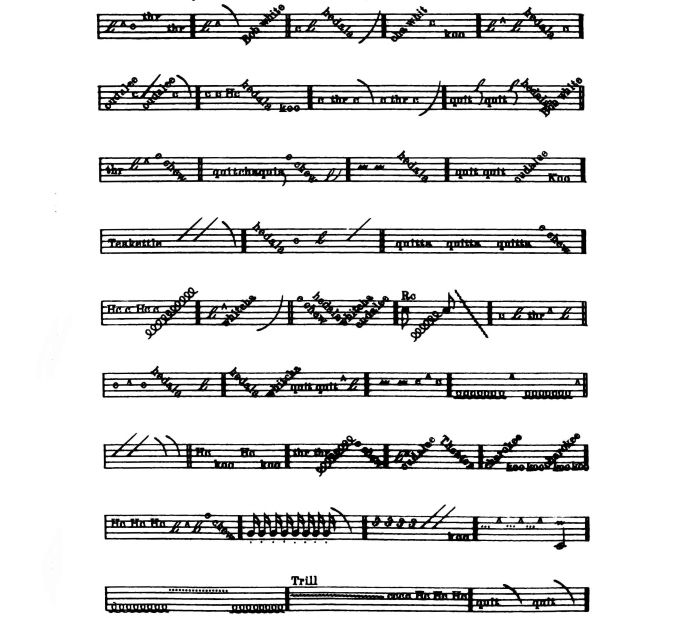
This is the call of the Eastern Quail, and is comprised of a staccato note and a whip. Whistle the first note very short, and the second a sliding whip, thus:—

[Listen]
This bird often precedes his last stroke with two staccato notes, thus:—

[Listen]
For illustrations of the songs of Eastern (U. S. A.) birds see “Fieldbook of Wild Birds and Their Music” by F. Schuyler Mathews.
This is one of the calls of the California Quail, and is heard in almost every section of the state, particularly in the flat country and the foothills.
This figure is comprised of a chirp, two “K” strokes, one sliding high and the other a low “K” stroke, thus:—

[Listen]
The California Quail often whistles an extra “K” stroke on the same pitch as the first stroke (the chirp) thus:—

[Listen]
The Pigeon has an odd song—“Look-at-de-coo”. Drop pitch of “coo” a trifle.
This song is comprised of three or four high marcato notes, followed by a rapid succession of staccato notes, from the last of which a little quivering drop is made, then quickly ascending, feathering off daintily, thus:—

[Listen]
This songster often uses a high trill, preceded by four short notes.

[Listen]

This song, familiar to almost everyone, is one of the sweetest and most delightful of its kind. It is comprised of a trill which lifts and lowers in pitch and runs at once into a succession of rapid chirps, these being followed by a gliding “upward cry”, and a rapid succession of the same figure ending with one long drawn out cry. The song closes with three high marcato notes, a slide being made from the last one to three more marcato notes about a fourth or fifth below. For example, take the pitch of “G” and slide into “D” (fourth line) and then end with an abrupt chirp much lower in pitch. (Note * in following).

[Listen]
This has already been explained in the preceding series of lessons. See page 45. The song in its common form will appear in notes, thus:—

[Listen]
To obtain the desired effect; whistle very rapidly the “hedala” and balance of song.
This songster combines the calls, songs and notes of all other local, kindred birds, and there seems no better way to illustrate his daily and nightly rapturous expressions than by imitating with the human whistle.
Some Mockers vary their methods considerably, often repeating one figure many times, while at other times, they make use of an entirely different arrangement of notes.
It has been said that these wise little fellows listen carefully during the day while the various other birds are singing, and at night, when all is quiet, they rehearse what they have heard during the day. This may or may not be true, but one thing is certain, the Mocking Bird is one of the most beautiful of songsters and possesses a far more extensive repertoire than any of the other birds.
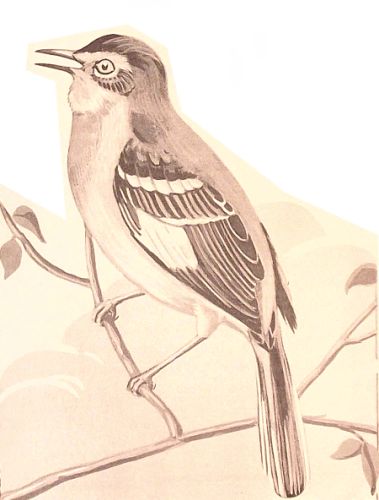
THE MOCKING BIRD
The songster that has given the greatest variety of bird notes and figures used in the Woodward Method of Bird Whistling.
(Reprinted by permission of the Whitman Publishing Co., Racine, Wis.)
The following may give some idea of his various musical combinations. Whistle exactly as the words sound.
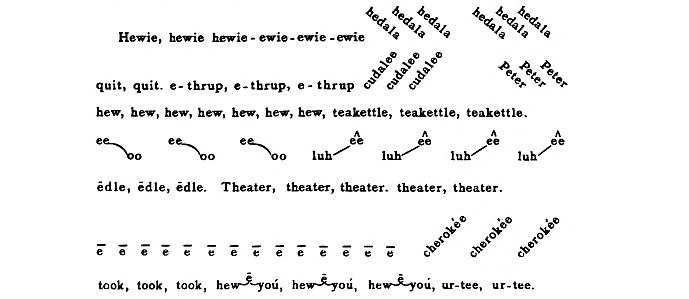
The above is only a partial list of this bird’s many beautiful and various notes. The word “pretty” is used repeatedly, also “derelic”, “Kubelic”, and many other unique and musical sounds.
THE ROBIN haw a cheery song, reiterating “ee-oo, hew-you-ip, hew-you-á” etc., thus:—

[Listen]

[Listen]
This little bird is often heard on the trails to Mt. Wilson and Mt. Lowe in Southern California, and on other mountain trails and in cañyons in various sections of the state. He is sometimes called “the scale bird”.
Whistling, in order to be thoroughly enjoyed, should be well-rendered, of pleasing quality, and thoroughly in keeping with the style of the selection. Bird notes, staccato figures, and other bright motives should be employed in brilliant concert numbers and selections bearing bird titles. These should be introduced and used intelligently and not thrown in promiscuously without thought for their euphony. Some selections in which these bird figures may be used, are the following:—
| The Nightingale’s Song | Nevi |
| The Nightingale and the Rose | Thompson |
| The Mocking Bird | Winner |
| Woodland Songsters | Ziehrer |
| Springtime of Love | Moszkowski |
| Springtime of Youth | Eggett |
| Invitation | Owen |
| Amorita | Grunn |
| Manzanillo | Robyn |
| Gondoliers | Nevin |
| Liebesfreud’ | Kreisler |
| Liebestraume | Liszt |
| Spring Song | Mendelssohn |
and many others
Smooth, even whistling, with pronounced crescendos and diminuendos, effective portamentos, and occasional bird figures such as bird chirps, reverse chirps, hewie chirps, yodels, lups, upward and downward cries, etc., may be employed in slow, sustained and sad selections and some love ballads (but used with taste),—for instance in such songs as “The Star” (Rogers); “Oh, Lovely Night” (Landon Ronald); “I hear You Calling Me” (Marshall); “Somewhere a Voice is Calling” (Tate); “Elegie” (Massenet); “At Dawning” (Cadman); “One Fine Day” (from the Opera “Madame Butterfly”); and many others.
Attack a plain note definitely on the note head. Do not scoop from underneath. Always think, feel, and hear the tone before striking it. Do not guess at the pitch.
Do not take breath before a final note in a phrase or at the close of a selection, unless the note is preceded by a grace note; or unless the note has above it the symbol representing a mordent or a reverse chirp, and then an unnoticeable breath may be taken if absolutely necessary.
Whistling generally uses more breath than singing, especially when bird figures are interpolated, hence breath marks are often indicated in whistling where they would not appear in singing.
All notes having over them the little mark ⌃, should be whistled plain. If more than one note on the same pitch is used, be sure that each is heard definitely and distinctly, and not held, otherwise the effect will be like a tied note. At the same time, however, the phrase should flow smoothly and connectedly.
When the little sign ⌃ is used in combination with other symbols, it indicates a staccato note. When used alone above a single note, it indicates a plain note (not staccato).
Where smooth slides are written, either up or down, be sure that the sweep is very smooth and connected from one note to the next. Do not scoop beneath the note, but glide evenly and directly into it. When “upward cries” are written from a given note, be sure that the sweep commences directly from the note head. The same principle is to be observed when a “downward cry” is used.
Where groups of smooth triplets are written, either on one pitch or on different pitches, be sure to whistle these easily, quickly, and without effort. The execution should be clear-cut and definite. Watch carefully that the middle note does not reach too high. Do not connect between the groups.
In whistling staccato runs, do them briskly, sharply, and definitely. Do not attempt to vibrate the tone as it is impossible to whistle a clear, sharp staccato run unless the vibration is checked, and the tones kept well forward, pointed, and clear.
Always observe the marks of expression where indicated, making swells where written, commencing softly and swelling in volume, and then allowing the tone to die away to a mere breath. Never drop a note abruptly unless marked staccato.
Do not use too much vibration when the tone is making a diminuendo or the effect will be shaky and uncertain. Allow just enough air to float the tone, conserve as much as possible while the note is being held, and then allow the sound to fade away softly.
Always work for artistry and variety. Make the dramatic passages dynamic and with full power; contrasting with soft passages, where feasible, and whistle these softly, sweetly, and with expression.
Do not continue the practice of whistling when the muscles of the lip and chin are tired and weak. Rest for several minutes before proceeding. Too long continued practice at a time will weaken the muscles. Divide the work into ten or fifteen minute periods. In difficult exercises, practice slowly at first, then, when proficiency is acquired, increase the tempo.
In the marking of whistling selections, great care should be exercised to avoid overloading the composition with too many bird figures and particularly those figures which have no bearing on the selection in question. Also watch carefully that there will not occur too many repeated “upward strokes” before a countering “downward stroke” is employed. Also avoid continual whistling. Intersperse with piano interludes at convenient intervals. The ears of a listener become tired when forced to hear constantly the sharp vibrations of the whistling tone. By the generous interpolation of piano interludes (when possible) the selection is made far more attractive, and the listener is afforded variety and freedom from monotony.
In whistling (pucker whistling) the lips should be firmly tensed at all times, but particularly so on high notes. Here a very noticeable drawing is felt in the center of the pucker of the lower lip and continued down the muscles of the chin.
Do not mouth the tones. In other words, keep the mouth and jaw still. Whistle as many figures, or as long passages as possible without changing the lip position. The manner in which some students open and close the lips continually, reminds one of the gaspings of a fish out of water! Particularly is this habit noticeable in the whistling exercises where figures are taken on every note in the scale. Whistle at least three or four figures, relax the lips a trifle for breath, and continue the balance of the scale (or exercise) without a change.
The less motion of the lips at all times, the better! However, allow the fullest possible play to the tongue.
Whenever possible on long sustained notes, make a decided swell in the center of the tone, allowing it to fade away faintly. The crescendo and diminuendo of notes is one of the most effective and artistic, and at the same time, difficult feats to perform. Allow a pronounced force of vibration to occur when the crescendo is at its height, keeping the lips firmly tensed and the tone steady and true to pitch. During the diminuendo, check the vibration somewhat and allow the tone to float evenly and continuously to the finish.
Practice daily an exercise on plain tones, beginning softly, swelling considerably louder in the center of the tone, and then gradually diminish, floating evenly without a break to the end.
In attacking the chirp (“hew” sound) the tongue which is lying easily against the lower teeth, suddenly jerks back and down. The motion is very quick. If, however, the chirp is to be held, the tongue retains its last position during the continuance of the plain tone or for the length of time desired.
With some whistlers the action in the making of the chirp, is very pronounced, while with others, the motion is hardly perceptible, the size of the tongue, shape of the mouth and general formation of the oral cavity, determining to a great degree, the amount and form of action in all bird figures.
In attacking the “ℓ” or “lup”, the tongue at its tip gives a pronounced stroke in the roof of the mouth as though whistling the word “loo”. First, however, the lips should be puckered in their natural position, and then simultaneously with the whistled tone, the tongue makes its quick stroke in the roof of the mouth as just described. Do not move the lips.
In attacking the “hedala” (pronounced “hee-da-la”) the tongue which lies in its normal position near the lower teeth while the first syllable is being whistled (keeping in mind the sound of ē), quickly strikes with its tip the roof of the mouth on the ridge back of the teeth on the syllable “da”; and before it has time to fall back to its normal position, again presses quickly against the roof on the syllable “la”. By continued practice the figure will be made so rapidly that the second syllable almost blends with the first syllable, thus:— “hedl-la”.
In attacking the “cudalee” (pronounced “kuh-da-lee”) which has the “K” stroke, think simply of the word “Koo”. It is a deep sound made far back in the mouth near the palate. The tongue is practically passive, although a slight motion may be felt through the broad part at the back.
In attacking the “took” (which is the “t” stroke and very little used), the tongue hits the ridge of the mouth back of the teeth as tho’ whistling the word “two” and making it very short. Keep the lip and chin muscles very firm, forming the pucker in advance of the whistled tone, and then give a stroke of decision and strength.
In attacking the “whip”, the tongue, drawn back from the lower teeth a trifle in order to gain strength, quickly shoves forward again, the front part making a decided forward stroke, although the tip is constantly touching the lower teeth. Do not allow the tip to come up to the edge of the teeth or the tone will have an unpleasant spitting sound. In the making of the “whip” the tongue moves forward and upward.
In attacking the “trill” (either to sustain or as a quick stroke), the tongue twirling rapidly is carried with the whistling sound against the roof of the mouth. If the tone is to be sustained with the trilling then the twirling continues as long as there is breath to support it. If a short stroke is desired (called “thrup”), then immediately after one rapid twirl in the roof, allow the tongue to fall back at once to its normal position against the lower teeth.

[Listen]
Practice in the various keys as high as possible, advancing a half step at a time, i.e.:— key C; key D♭; key D; key E♭; key E; key F; etc.

[Listen]
Practice in the various keys,—ascending only.

[Listen]
Practice in the various keys,—descending only.

[Listen]
Practice in the various keys,—ascending only. Various Bird Songs as heard, imitated, and notated by some of the authorized instructors of the “Woodward Method of Bird Whistling”.
————
Marjorie Clark Kennedy (Mrs. Paul J. Kennedy), Spokane, Wash., hears near her home the cheery little song of Robin Redbreast:

[Listen]
Whistle on higher pitches if possible, i.e.—high “G” down to “E”; and whistle rapidly.
Another notation of the Robin’s song (using the chirped mordent).

[Listen]
Gertrude Willey Anderson (Mrs. B. C. Anderson), Aspinwall, Pennsylvania, hears repeatedly at the feeding station in her yard the crisp little song of the bright-colored Cardinal. He seems to call,—“What year? What? What? What? What year?”

[Listen]
Evellyn Kendrick Leitzell (Mrs. Paul Leitzell), Los Angeles, Calif., has caught the entrancing song of the gaily-colored Oriole, which she hears outside her window.

[Listen]
Lota Stone (Mrs. E. H. Stone), Portland, Oregon, enjoys notating the songs of birds not usually imitated, for example the song of the White-crowned Sparrow:—

[Listen]
Hellen Ward Jeffs (Mrs. Milton Jeffs), Los Angeles, Calif., has cleverly adapted from the victrola record the song of the Nightingale,—a portion of which is herewith given:—


[Listen]
(By sound and syllable:—oó-ee; whit-te kóo; whit-te what, édle; hew, hew, hew, hew, hew, hew; pur-te-bird; three ē; hew (six times); ē; koo, koo, koo, koo; trill ⁓⁓⁓⁓⁓⁓⁓ hew (six times), ē.)
Gertrude Klashke, Seattle, Wash., is interested in the song of the Varied Thrush which she hears near her home, and also in the country. This bird is sometimes called the Alaska Robin.

[Listen]
(By sound and syllable:—hew, hew; whée-ah, whée-ah; hew, hew; whée-ah, whée-ah).
Betty Greene, Wichita, Kansas, enjoys imitating the little Chickadee and his cousin, the Phoebe Bird:—

[Listen]
(By sound and syllable:—chickadee (exactly as pronounced); The Phoebe bird,—ēē ah).
Bertha Caroline Stockwell, Los Angeles, California, has carefully studied the song of the Black-headed Grosbeak which she has repeatedly heard in the woody section near a river in the outskirts of Los Angeles.

[Listen]
(By sound and syllable:— hew; hew-ee-éw; hew-a-ée; ah-oo; three (ascending trill); hew-a-ée; hew-a-ée; hew-a-ée; three (ascending trill) up into “E”).
Marion Sevier Darlington (Mrs. Keith M. Darlington), Los Angeles, Calif., heard on a trip through the State of Utah, a rather different song of the Meadow-lark:—

[Listen]
(By sound and syllable:—hedala, hedala, lúh-ēē, luh).
Another meadow-lark song which she notated from a Los Angeles bird and she used in a movie cartoon.

[Listen]
(By sound and syllable:— eedleladleladlela; e-ah; ahdleladleleedlelee. Or eedle-ladle-ladle-la; e-ah; ahdle-ladle-leedle-lee). The yodel effects to be whistled very rapidly.
Jean Smalley MacMurray (Mrs. Samuel MacMurray), Los Angeles, Calif., has made an intensive study of the call of the ring-neck dove:—

[Listen]
(By sound and syllable:—ah; ah ⁓⁓⁓⁓⁓⁓⁓ oo).
Madge Becker Quimby (Mrs. Elbert Quimby), San Pedro, Calif., accurately imitates one of the California meadow-larks:—

[Listen]
(By sound and syllable:—ah, oh, e; hedala, hedle-oodle-oodle-oodle, luh). The yodel effects to be whistled very rapidly.
Maude Miller Houdek (Mrs. Carl Houdek), Muscatine, Iowa, hears in her cherry tree the sweet song of the Baltimore Oriole.

[Listen]
(By sound and syllable:—hedle, hewie; hedle, hedle, hedle, hewie).
Originated and outlined by AGNES WOODWARD, Director of the Agnes Woodward School of Whistling, Los Angeles, California.
What is the first general exercise in whistling used for development of range, power, and tone quality? Write it.
What is the definition of a bird chirp? How written by note and how expressed by character?
What is the definition of a “hewie chirp”? How written by note and how expressed by character?
What is the definition of a “reverse chirp”? How written by note and how expressed by character?
When the bird chirp is whistled sharply as a single stroke, or used rapidly in successions, what word expresses the sound? How would the succession of chirps appear written with symbols?
What is the wave? How written and how expressed? On what pulsation (for practice) do we stop?
What is the trill? How made and how expressed by character? In addition to the tongue trill, what are the other principal ones used?
What are the “quittas”? How whistled?
Define a mordent. How written by note and how expressed by character? What is the common fault among pupils in the making of this ornament?
What is triple-tonguing? How written? Explain reason for name.
What is the triplet? How made? How expressed? What is the common fault among pupils in the making of this figure?
Define a whip, also the “upward and downward cry”. What characters are used to express each?
Define yodel. How made? How expressed?
What is the “lup”? How made? How expressed?
What is the “lup-ee”? How made? How expressed?
What is the “e-lup”? How made? How expressed?
What is the “lah-ee”? How made? How expressed?
What is the “lee-ah”? How made? How expressed?
What is the “chut-ee”? How made? How expressed? Reason for name?
Define the “whit-cha”. How made? Reason for name?
Define the “e-chew”. What is the difference between the “whitcha” and the “e-chew”?
What is the “thrup-ee”? How made? How expressed? The E-thrup?
What are the two principal liquid bird figures based on the yodel? Define.
Write Bugle Exercise No. 1 and Bugle Exercise No. 2.
Write three different bird exercises.
Write five octave exercises.
Write a chromatic scale descending, also the long stacc. chromatic Ex.
Write definition and characters expressing the Meadow-lark’s Song.
What is the call of the Eastern Quail? What is the call of the Western Quail?
Write as many Mocking Bird figures as you can recall.
Write as many different bird songs as you can recall.
Of what especial advantage to the whistle is the staccato work? Of what advantage is the legato work?
Write the “K” exercise. Write also the “E-thrup” and “K” exercise.
Write two or three staccato exercises.
Write one or two “hedala” exercises.
Write all of the “upward figures” you are able to recall.
Write all of the “downward figures” you are able to recall.
What is the turn? Define it. What is the character used to express it?
Write and define the ascending and descending yodels, dipped yodels and ascending and descending quivers. What is the action of the tongue on each, particularly on the yodel?
Define the proper manner of breath control. Also the position of the under lip as regards tension.
In the marking of music for whistling, what main points are to be observed? Also what faults to be avoided?
Write several combinations of bird figures, for instance like the following;—

Write the characters expressing the Canary’s Song.
What two exercises, as a rule, are used in a whistling test?
What are some of the requisites of a good whistler?
What is the proper standing position for a whistler? How long should the whistler practice each day? What length periods?
Write the following notes and corresponding rests:—whole; half; quarter; eighth; sixteenth; thirty-second; sixty-fourth. How many quarter notes in a whole note? How many 16th notes in an 8th note? How many 8th notes in a quarter?
What do the following symbols mean: ⦟ ⦟ ⦣ ⦣ ⩀; D.C.; Dal Segno; fine; rit.; rall.; accel.; presto; rubato; allarg.; dolce; vivace; appassionato; allegro; andante; a tempo; fortissimo; f; ff; fff; p; mp; pp; ppp.
In dealing with “tongue and teeth” whistlers, what figures need to be substituted for the yodel, lup, hedala and cudalee?
Name two or three suitable selections for beginners. Name also two or three difficult selections for advanced students, numbers appropriate for concert use.
GEO. STEVENS
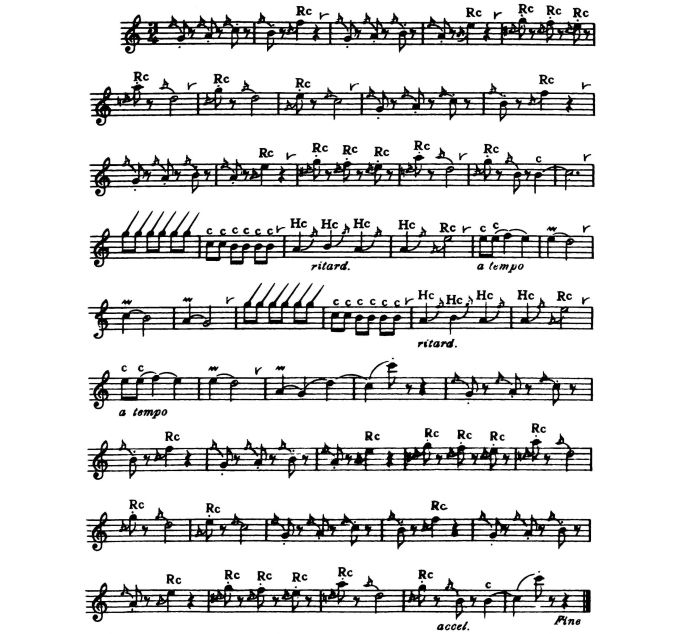
[Listen]
Copyright MCMIV by Will Rossiter, Chicago, Ill. Used by permission.
Key to “MOON WINKS” (Stevens)[5]
An introduction may be used giving the first three measures of the selection and ending with an appropriate chord (or chords) on the keynote (in the fourth measure).
Whistle lightly the indicated grace note and slide at once to the plain note below, connecting the notes. This you will notice is the “bird chirp” (having different intervals). Repeat idea. In making the “reverse chirp” attack the grace note below with the sound of “hew” and swing quickly to the upper note. Note here (in the fifth measure) that the markings for the whistler are “reverse chirps” while the pianist plays as written in the sheet music.
The first sixteen measures are filled completely with chirps and “reverses”, explanation of which has been previously given. Do not hold the “reverse chirps” but make them short (as written).
In measure seventeen make the “whips” terminate on high “G”; commencing on the “E” below (the distance of a third). In the following measure, whistle the short chirps (sound of “hew”) directly on the pitches, and in the next measure whistle three “hewie chirps” giving the attack of “hew” on the lower notes and sliding up to the indicated grace notes above, letting go quickly of these. Remember that the accent comes on the long note (the first note), and that the three are whistled on the three even beats. Another “hewie chirp” occurs in the next measure, followed by a “reverse chirp” (pitches from “G” to “E”: fourth space). Hold this half note its full two counts. Then chirp brightly on the two notes at “a tempo”, sliding from the last chirped note to high “F” and on over to “E”. Mordent on the quarter note (this quarter note is substituted for the original eighth note and rest,) and from this slide smoothly to the half note, holding this its full count. Repeat idea.
The balance of the selection (as much as is used for a study) is easy to interpret. End with a swing from the “C” in the third space to high “C” making this a dashing “whip.” End selection here. This may be used for an encore.
[5] Refer to the regular piano or song copies when working out the “Keys”.
OLCOTT-BALL
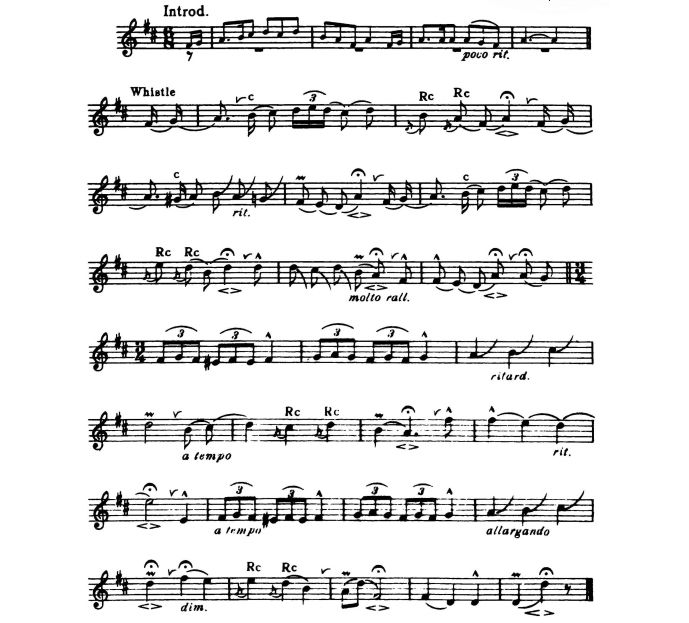
[Listen]
Copyright MCMX by M. Witmark & Sons, New York. Used by permission.
Key to “MOTHER MACHREE” (Olcott-Ball)
Key of D
Slide smoothly from one note to the next, the curved lines indicating legato work (connected notes). Take breath where marked with check ⩗ and if additional breath is needed at other points, be careful to take quietly, quickly and unnoticeably (where the phrase will admit of it, and not be broken).
Chirp on “B” (making the “hew” sound directly on the note,) holding it and sliding to the following note without a break. Make a triplet on “D” and from it slide into the notes following. Where the two “Rc” characters are expressed, make these from the pitches of “D” to “B,” and “D” to “A” respectively, remembering that each attack has the sound of “hew” and that the accent is thrown on the second note of each figure. From the last “reverse chip” whistle smoothly to the notes following, holding “A” and making a finished crescendo and diminuendo at this point.
Take up again the melody and deal with it as previously explained. Where the “upward cries” are indicated, take these directly from the given pitches, feathering off delicately and sweetly. Remember in the making of the “upward cries” that the heavy accent, comes on the note out of which the cry ascends, and that the last of the sound (at the close of the cry) should be very faint. In the measure following, mordent on “F♯” and glide to the notes which follow, taking the “A” instead of the “E” (as written in the sheet music), holding it and making a crescendo and diminuendo. Again take up the original theme, treating as previously explained. In the next measure (where again the two “Rc’s” are expressed), whistle from the grace note of “G” into the respective pitches, making the “hew” attack on the grace note, and gliding to the plain notes above. From the last “reverse chirp” whistle smoothly to the next two notes, holding “D” and making another crescendo and diminuendo. Then strike with a plain whistled tone the next “D” and follow it with “downward cries” directly from the pitches, accenting definitely the notes from which the cries descend. This effect you will notice will be very sad,—almost a wail!
Mordent on “B” and slide to “A”, holding it and making a slight swell. Then whistle a plain tone on “F♯”, and follow in the next measure with the smooth melody (as indicated), again holding the last note and making the usual crescendo and diminuendo. Take breath, and whistle smoothly the next two notes.
Now take up the ¾ tempo with smooth triplets, whistling one to each of the first two beats, and end each measure with a plain note. Although the notes of the triplet are smoothly connected, do not connect the groups. Where the “upward cries” are indicated, take these directly from the pitches written, accenting definitely the note from which the figures ascend. Feather off delicately. Mordent on “D” in the neat measure, and follow with the melody on the next three notes, making the “reverses” as explained elsewhere. Mordent on “B” in the following measure, and slide to “A”, holding it and making a crescendo and diminuendo. Then softly take the next phrase an octave higher than written in the sheet music, hitting a second time the high “F♯” over which is the little character ⌃. Close with a swell on “E”. Again take up the refrain and treat in same manner as before. In whistling plain notes, either high or low, always watch carefully that the note is struck definitely, and not reached with a slide (or scoop) from underneath.
In the third measure from the last, mordent “A” and slide quickly and evenly to “D” and down to “F♯”, holding this note sufficiently long to make a swell. Then close the selection with the melody whistled smoothly, hitting the note over which is the character ⌃, and making a mordent in the next measure on low “D” gliding up an octave and holding the upper “D” until it gradually fades away.
BERNARD HAMBLEN
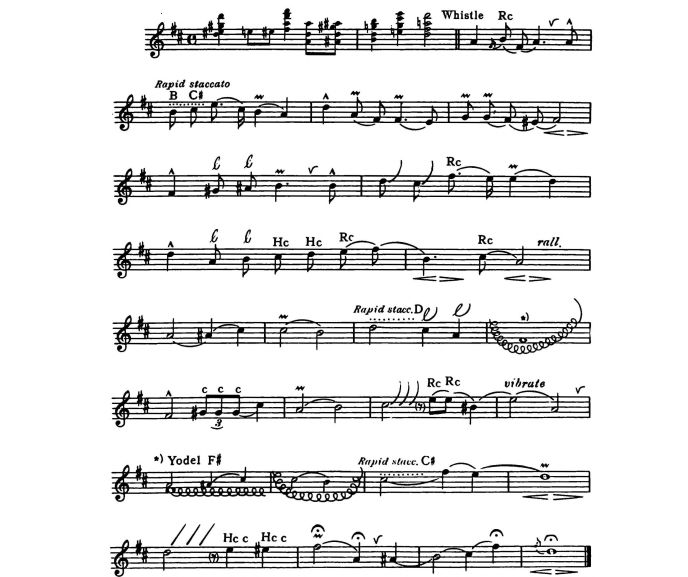
[Listen]
Copyright MCMXVIII by Carl Fischer, New York. Used by permission.
[6] Pianist is to emphasize small melody notes during yodels.
Key to “ROSES OF MEMORY” (Hamblen)
Piano introduction of two measures. Whistle first note plain and take a “reverse chirp” on the second note (the under grace note being “F♯.”) Follow smooth melody as indicated, connecting from one note to the next. Where succession of staccatos is written, whistle as many on the pitches of “B” and “C♯” as is possible to get in on the two notes, and then swing smoothly to the upper note and down to “C♯” (as indicated). Mordent on “B” and slide to “A”. The next two measures are easy to decipher. In the fifth measure, after the plain tone on “F♯”, whistle “lups” directly on the given pitches, and follow these with a mordent on “B”. Whistle the same pitch again with a plain tone, and in the following measure take the “upward cries” from the pitches given these cries will of necessity be quite rapid since the notes are eighth notes. Then “reverse” on high “F♯” and swing over smoothly to the notes following, observing the mordent on “E”. In the succeeding measure, whistle “lups” on the exact pitches, also “hewie chirps” catch the “reverse chirp” on “E” and swing up and down smoothly on the next two notes. Make a slight swell on the last note. Again “reverse” on “C♯” and slide to “A”, holding this and making a crescendo and diminuendo.
The next two measures are easy to decipher. Whistle smoothly and with expression. Whistle as many staccatos on “D” as is possible to get in on the two beats, and follow with the “lah-ees” from “C♯” and “A” remembering that a “lah-ee” is simply a “lup” out of which an upward cry ascends. The “dipped yodel” starts high, yodels down and up again and feathers off sweetly in the same measure. After holding the half note on “F♯” the required two counts, whistle three quick “chirps” on the pitch of “G♯”(treating as a triplet) and from the last one, slide up to “C♯”. Now mordent “A” and go evenly to “B,” holding required number of counts.
Whistle three “upward cries” from the pitch of “C♯” making all three on even 8th notes,(an 8th rest being introduced before “reverse” chirps on “E”.) Make the “reverse chirps” also even 8th notes and from the “B” sharp swing smoothly to “E” and down to “A.” Vibrate exceedingly on the high note “E.”
Now yodel F♯ and follow with a dipped yodel. In the measure following these, staccato the pitch of “C♯” (as many as is possible to get in on the two counts,) and glide up to “F♯” and over to the notes following, making a mordent on the last note. Crescendo and diminuendo at this point.
Where “whips” are written, take these as three even 8th notes allowing an 8th rest to be introduced before the “hewie chirp.” Then whistle the “hewie chirp” directly on pitch and follow it with a short chirp (also on same pitch,—which is “E”) and repeat figure with pitches on “E♯.” Mordent high “F♯” and slide down to “A,” making a slight hold here. Then take up the melody notes and follow as written to the high “F♯”, holding this, again hitting same pitch with a grace note and dropping quickly and smoothly to the last note “D”. Make a crescendo and diminuendo here, allowing tone to die away to a mere breath.
CLARE KUMMER
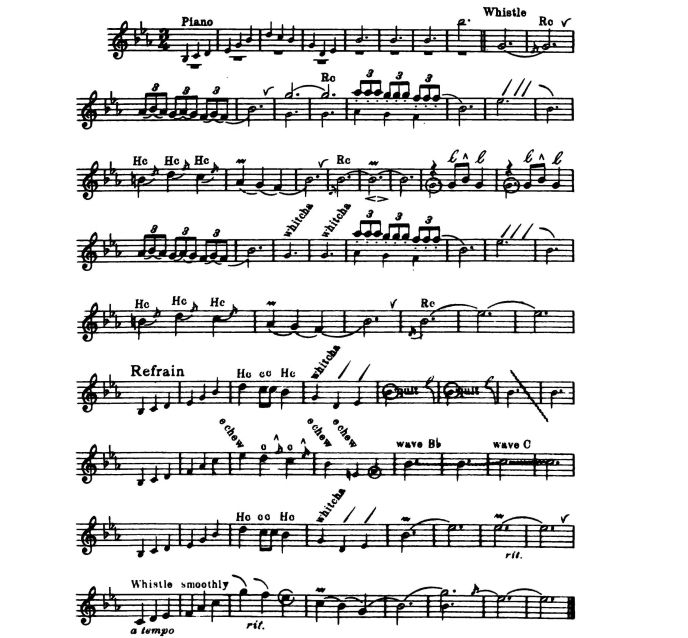
[Listen]
Copyright MCMXVI by Jerome H. Remick & Co., New York and Detroit. Used by permission.
Key to “THE BLUEBIRD” (Kummer)
Key of E♭
Hold first note until ready to make the “reverse chirp” and then allow the tone to cease for a second while the under part of the “reverse” is being struck, again remembering that the attack has the “hew” sound, and quickly slides to the upper note. Hold this note its full value. Then whistle smooth triplets on the notes written, (but do not connect the groups), and from the last triplet glide smoothly to the dotted half note in the next measure. Now take sustained note and “reverse chirp” as before, only whistle an octave higher. If, however, this is too high, whistle the three measures an octave lower (where indicated in the music.) Following the “reverse chirp”, note that three sharp staccatos are given on each of the quarter beats and from the last one, a slide is made to the half note in the next measure. Follow this with three brilliant “whips” on the three even beats in the one measure, and one “downward cry” in the next measure. Do not try to put this cry on any definite pitch, keep it high, and feather off as it descends. Do not whistle into the given pitch, nor have any accent on the last of the cry. As indicated, whistle three “hewies” on the notes written, making these the distance of a third in each case. Then mordent “A flat” and swing smoothly to the following three notes. Whistle a “reverse chirp” on “B flat”, holding it until ready to make the mordent on same pitch. Hold this note six counts. Omit the first beat in the next measure, and whistle a “lup-ee” on the 2nd beat and a single “lup” on the 3rd beat. Repeat idea. Whistle smooth triplets and from the last one glide up into the “B flat”. In the succeeding two measures whistle bright “whitchas” above the staff, on the first beat of each measure.
Now make staccato triplets (triple-tonguing) on the high notes and swing from the last group down to “B flat”, holding three counts. If the staccatos are too high for whistler, take an octave lower and swing up to “B flat”. Then deal with the “whips”; “downward cry” “hewies” mordented phrase and smooth notes as previously explained. Reverse on “B flat” and swing up to “E flat”, holding this its full value.
REFRAIN.
Pianist plays two measures. Then whistle a bright “hewie” on the note indicated, two little chirps on the next note, (making these the value of two even 8th notes.) and a final “hewie” on the last note. In the next measure, whistle a brilliant “whitcha” on the first beat and follow with two “whips” on the 2nd and 3rd beats. Keep the “whips” high. Do not attempt to follow the melody here. The pianist will take care of this.
In the next measure, allow the first half of the first beat to be an 8th rest, and then on the last half of the beat, whistle “quit” (pitch of “B flat”) and follow on the 2nd beat with a “lee-ah”, starting the “lee” on “E flat” and letting the “downward cry” glide from it quickly. Repeat idea. Next, start a high “quiver” from “F” and continue down (like water trickling over pebbles) until the low pitch of “B flat” is reached, or until the sound is lost in the piano accompaniment.
After the next piano interlude of two measures, whistle a sharp “e-chew” on the first beat, a “chut-ee” on the 2nd and 3rd beats, and remember that the “chut-ee” is simply a chirp disconnected from a staccato note a third higher. Repeat “e-chews” in next measure, allowing the last beat to be a rest for the whistler. Now “wave” the pitch of “B flat” and continue wave into the pitch of “C”. The next few measures are easy to decipher.
In the sixth measure from the last, whistle two “downward cries” slowly, (starting from the pitch of “G”) and fading off quickly and gently about a fifth below. Then whistle a mordent on “C” and follow smoothly on the notes indicated, taking high “G”, repeating pitch on a grace note and swinging down quickly to the final note (“E flat”). Hold.
ROBERT HOOD BOWERS
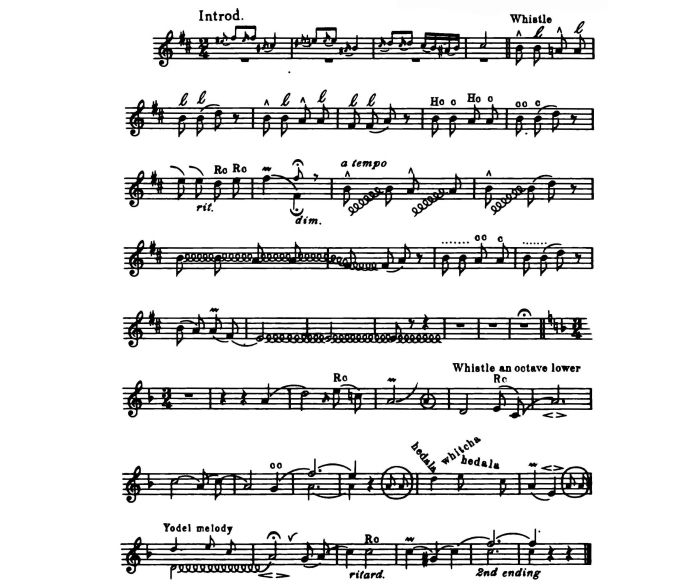
[Listen]
Copyright MCMXIX by G. Schirmer, New York. Used by permission.
Key to “CHINESE LULLABY” (Bowers)
Piano has introduction of four measures. Then whistle commences with a plain whistled tone on first note followed by a sharp “lup” on the second note, and in the second measure two “lups” on the pitch of “B” a quick slide to “D”. Repeat idea for the next two measures. Then whistle a bright “hewie chirp” on the “B” (making the upper part of the “hewie” reach “F♯”) and follow with a short chirp on pitch of “B” Again whistle a “hewie chirp” (pitches “A” to “F♯”), and follow this with another short chirp on pitch of “A”. In succeeding measure, whistle two short chirps on the pitch of “B” (treating as though sixteenth notes) and from another chirped note on same pitch, slide smoothly to “D”.
The “downward cries” may be taken directly from the pitch of “E” or (if preferred) from the higher pitch of “G”. Make these very pathetic. Follow with two “reverse chirps” (pitches of the first from “A” to “D”, and the second “B” to “E”), and in next measure mordent high “F♯” and slide down an octave to the lower “F♯” holding for a slight diminuendo.
Again take original theme but change the markings somewhat. Whistle first note plain, and on the second note yodel up into it from below (from the pitch of “D”) ending directly on the pitch note of “B”. Repeat idea for the next two notes changing to the given pitch of “A”. In next measure, from the last note into which the yodel ascends, carry this plain note smoothly to the third above (“D”). Then for two measures yodel the melody, coming into the last note with a plain whistled tone. If unable to yodel the melody, either wave or take it with decided vibration. Then come a succession of staccatos on the pitch of “B” (as many staccatos as is possible to get in on the beat), and follow these with three short chirps, making the first two come on the first eighth note (treating these as sixteenth notes) and follow with the other chirp on same pitch. In following measure again carry succession of staccatos on “B” and glide smoothly to the third above (“D”). End the phrase with the melody whistled very smoothly, evenly and connectedly, observing the mordent on “A” and from the last note gliding to the yodel on “E”. Continue the yodel as long as possible.
Beginning the ¾ time, whistle smoothly from the quarter note “A” to “D” (half note), making the “reverse chirp” on “E” (starting the “Re” on grace note “A”), then sliding from the “E” to “C♯”. Mordent on “A”, holding two counts and on the third count feather out sweetly with an “upward cry”. Omit circled note. Again whistle melody as just explained, taking the one measure an octave lower, and sliding from “C” up to “A”, making a crescendo and diminuendo here. Again whistle the melody notes smooth and evenly and in the second measure, take two bright chirps on “G” (treating these as two even 8th notes) and from the last one, slide smoothly to high “F”, holding full value and going into “E” in next measure. If too high, take melody notes as written in music. Omit circled notes. Whistle “hedala” on first beat of measure, “whitcha” on second beat, and “hedala” on last beat, making each figure come evenly on the three beats. Follow with a mordent on “A” (treating the “A” like a quarter note) and slide down to “E” (treating like a half note), omitting the circled notes. Now yodel the pitch of “D” and follow melody notes for one measure and slide to “A” in following measure, holding sufficiently long to make a finished crescendo and diminuendo. Then again whistle connectedly the melody notes, observing the “reverse chirp” on “C” and the mordent on the same pitch in next measure, also that the 2nd ending is taken, with the whistle climbing smoothly to high “F”. Hold as long as possible and diminish the tone.
(Notes to be whistled are large or are specified by name above staff.)
A. G. ROBYN
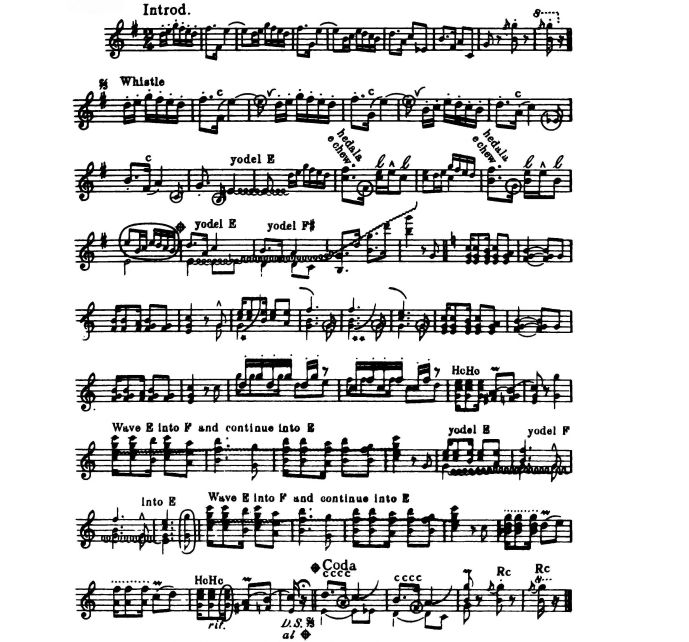
[Listen]
Copyright MCMIX by Leo Feist, New York. Used by permission.
Key to “MANZANILLO” (Robyn)
Accompanist plays eight measures as an introduction, and takes as a finish, the second ending at the last of the selection.
Whistle brightly the staccato notes as written, making a decided accent on the first note of the second measure (treating this as a staccato note), thus giving more dash and brilliancy. Chirp the low “F♯” and from it swing smoothly to “E”, holding this its full value. Do not, however, hold the tied note. Take breath here. Repeat idea for the next few measures. Omit all circled notes or group of notes. These will be played by the pianist.
Where the yodel on “E” is indicated, continue for a beat and a half. Omit the next six notes circled, and follow with the interpolative bird figures written,—“e-chew, hedala” on the first beat, and “lup-ee, lup” on the second beat, watching carefully that the first “lup” comes directly on the pitch of “C” in the one measure, and on the pitch of “B” in the second measure following. Note that the final “lups” end on the pitches indicated.
The long yodel which now occurs, should be whistled on the pitch of “E” for the first measure, continuing into the next measure on the pitch of “F”, and on to the following measure, touching “G” and from this pitch quivering up and ending with a dash. Stop when accompanist completes the phrase. Observe that the second ending is used instead of the first.
Now follows a piano interlude of four measures. In the measure following, take an “upward cry” starting from the pitch of “E”, and feather off about an octave higher. In the next measure, whistle a “downward cry” (covering the distance of a fifth). Repeat idea for the next two measures, noting that the second “upward cry” starts from the pitch of “F”.
Again occurs a piano interlude of four measures, followed by two measures of quick staccato effects,—in the first, the pitches being from “D” to “G” in each of the three cases, and in the next, pitches from “C” to “F”.
In both instances, the measures are filled with these figures and an 8th rest following each group of 16th notes. This must be whistled very rapidly in order to get in on time. Now come two even “hewie chirps” on one beat, followed by a mordent on “A”, a slide to “B”, and on to the final note of “C”.
The whistler will need to watch carefully through these measures and not be confused because of the syncopated time of the accompanist.
Now comes a long continued wave, starting on the pitch of “E”, going into the pitch of “F” for two measures and returning to the pitch of “E” in the fourth measure. Take breath. Then yodel “E” for one measure, into “F” for two measures, and back again to the pitch of “E”. Repeat “wave” as just explained, and follow with a succession of staccatos on high “G”, making a mordent on “D” and sliding over to “E”. Repeat succession of staccatos (this time on the pitch of “F”) and mordent on “C” and slide to “D”. Treat next two measures as previously explained.
The original theme is again taken up and dealt with as before. (⌖) The last four measures are a little different from the first theme however, in that four chirps followed by an “upward cry” are used. Whistle the four chirps on pitch of “D” (all in one beat), and the “upward cry” starting from “C” on the second beat. Repeat idea, but change pitches of chirps to “B” and take the “upward cry” from the pitch of “A”. Do not chirp the commencement of the “upward cry” (a common fault).
Take second ending,[7] making mordent on “G” (second line), a quick “reverse chirp” on high “G” (an octave above), and another quick “reverse chirp” on the same pitch. Make all of these figures very sharp and staccato. Have accompanist play last chord of selection two octaves higher than written, and very short!
[7] This is particularly for the accompanist, who omits the first ending at the bottom of page 5 of piano copy. There is only one ending given in notes for whistler at bottom of page 91.
JAMES H. ROGERS
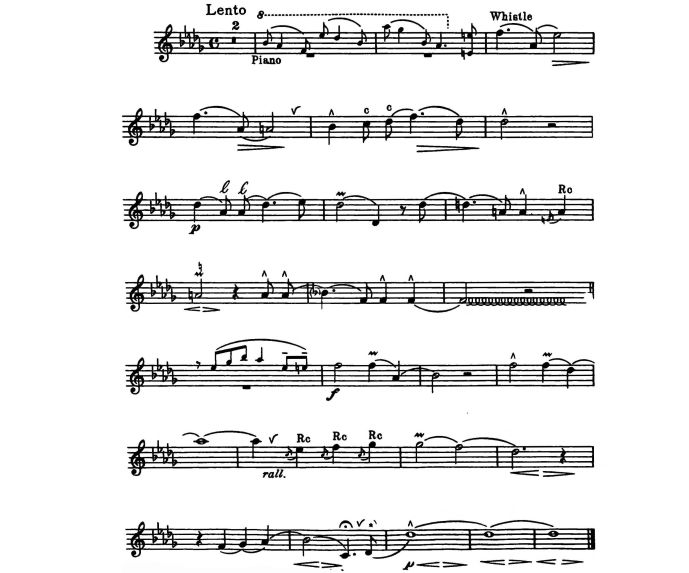
[Listen]
[8] Copyright MCMXII by G. Schirmer Inc. Used by permission.
[8] The eighth note not too short or hurried. [Footnote is within music.]
Key to “THE STAR” (Rogers)
Key of D♭
Whistle the first note directly on pitch. Do not scoop to the tone (a common fault). Swing down with a pronounced portmento to the “A flat” and up to the “E flat”. In the next measure, repeat idea, watching carefully that the pitch of “A natural” is accurate. Then hit firmly the “B flat” in the next measure, holding it the value of the quarter note, and follow with chirps on the 8th notes. Do not make the chirps sharp but let them have a rather pathetic sound. Slide from the last one to the upper note and on over to the notes following. Hit the last “D flat” with a plain whistled tone.
Again whistle smoothly from “D flat” to the “lups” on “A flat”, letting go quickly of the first “lup” and joining the second one to the following note (“D flat”) and whistle from that to the “E flat”, letting go so as to make a mordent on “D flat” in the next measure, and slide down an octave to low “D flat”. Then omitting the first 8th note above, whistle the second 8th note and from it glide to the notes in the following measure. Observe the reverse chirp on A. Be sure to make a pronounced crescendo and diminuendo on the “A natural”. The last two notes in this measure should each be whistled plain, and from the last one whistle smoothly to the note in the next measure, holding this its full value, and then slide to “F”, striking this pitch twice afterwards (as indicated). From the last “F” slide to the yodel in the last measure. Continue this yodel for one measure, or as long as possible. If unable to yodel, a succession of staccatos or the wave may be substituted, continuing for one measure. Observe short piano interlude.
Now whistle high “F,” hold its full value, mordent on the same pitch, and slide to the notes following. The same idea is followed in the next two measures. Have pianist take the run the entire length of the piano as this is the climax of the theme. Then with decision and firmness, take the “reverse chirps” slowly and with feeling, (the under part of the figure being each time on “C”), and follow with the mordent on high “G flat” and down smoothly to the notes following, making a crescendo and diminuendo on “D flat”. Wait in the next measure for the chord in accompaniment, then with feeling, whistle smoothly (connecting the tones) the melody as written, and glide from “B flat” to low “C” holding this sufficiently long to be impressive. Take good breath and close selection with a glide from the low “D♭” (eighth note) to “D♭” the octave above and if possible make three crescendos and diminuendos on this pitch. If unable to make three swells, whistle two, and allow tone to die away to a mere breath.
ROBERT CONINGSBY CLARKE
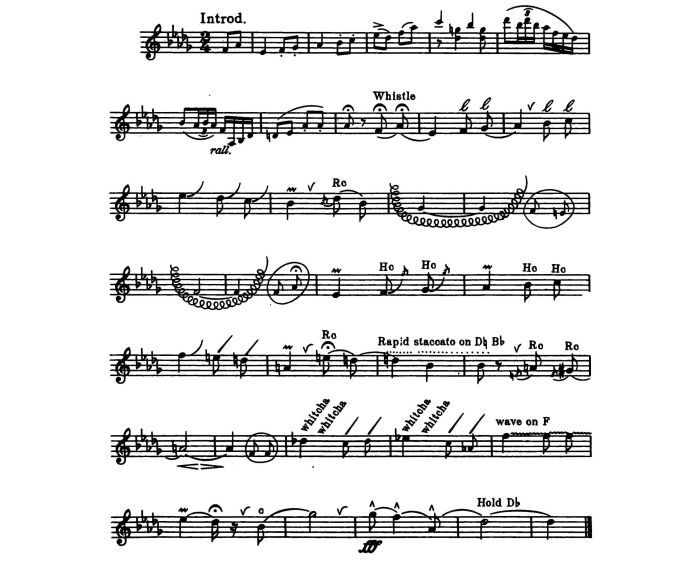
[Listen]
Copyright MCMX by Chappell & Co. Ltd., and reprinted by special permission of Chappell-Harms Inc., New York.
Key to “YOU, DEAR, AND I” (Clarke)
Key of D♭
Whistle smoothly the connected notes. Then make a quick “lup” on the “F” and another “lup” on the following note and from this glide into the plain note in the next measure. Whistle two more “lups” on the exact pitches, and in the following measure, make an “upward cry” ascend from the pitch of E flat. Follow this with two more “upward cries” from the eighth notes and notice that these will of necessity be much faster than the first one. Mordent on “B flat” and make a “reverse chirp” on “D flat” and glide over smoothly to the next note. Let go of this “B flat” at once, catch a breath (if necessary), and commence the dipped yodel, beginning high, dropping down, and again ascending and feathering off delicately in the following measure. Omit all circled notes.
Again whistle a “dipped yodel”, feathering off as before. Then mordent on “E flat” and follow with two “hewie chirps” (making these the distance of an octave), and repeat the idea. Again take an “upward cry” from the pitch of “F”, making this quickly so as to be ready for the next beat. Then make two bright whips on the two 8th notes, and follow with a mordent on “A natural”. Take breath, catch a “reverse chirp” on “E natural” and slide over to “D natural”, and on over to the successions of staccatos on “D natural” and “B flat”. Make as many staccatos as possible on each of the two beats, remembering to change the pitch to “B flat” on the second beat. Whistle “reverse chirps” on the notes indicated, and from the last one slide over smoothly to “A natural” in the next measure. Make a decided crescendo and diminuendo here.
Whistle “whitchas” and “whips” on the even beats, the two “whitchas” coming on the first beat, and the “whips” on the second beat. Whistle all of these figures high,—above the staff. Repeat idea.
Then wave (or vibrate) with full power the high “F” making a mordent on “E flat” in the next measure, and sliding smoothly to “D flat”. Hold this note. Catch breath and whistle (with chirped attack) the “B flat” and swing from it with full power to high “G flat”, holding two full counts. Take breath, whistle the high “G flat” again and carry smoothly to the following notes and the finish. Hold as long as possible.
Rudolf Friml
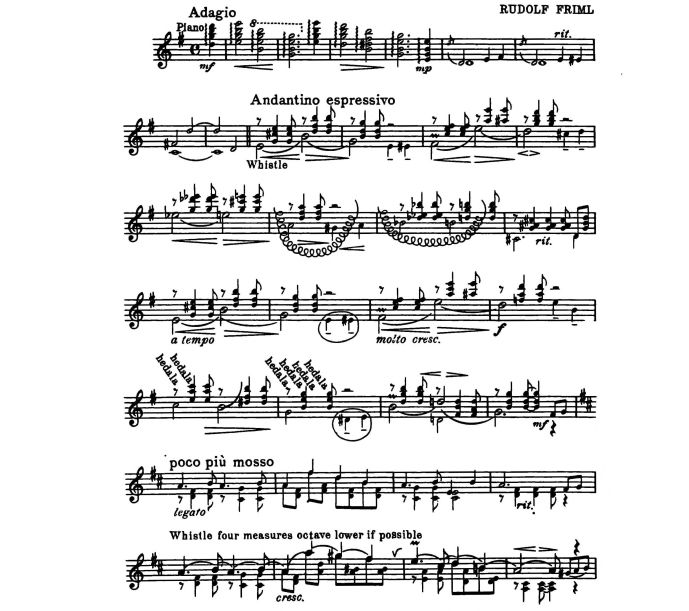
[Listen]
Copyright MCMXVII by The Boston Music Co. Used by permission.
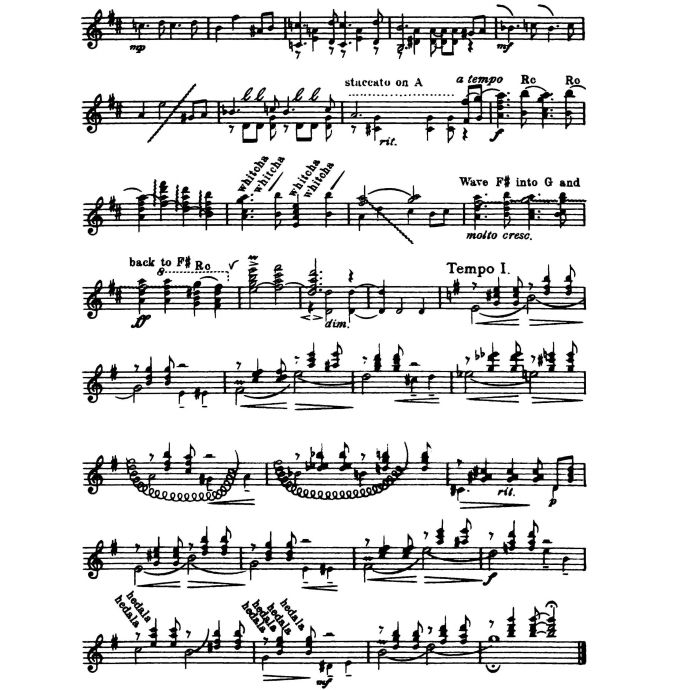
Key to “ADIEU” (Friml)
Pianist takes a prelude of eight measures. Whistle where indicated, going smoothly from one note to the next, making a decided sweep to the upper note. Repeat idea, starting the phrase with a mordent on “F♯”.
The large notes only are to be taken by the whistler, while both large and small notes are to be taken by pianist.
Whistle smoothly from “E flat” to “E natural” starting softly and swelling when the “E natural” is touched. The following “dipped yodels” start high (about F♯), roll down to the pitch of “D” and up again, feathering off daintily. For explanation of these refer to lessons on yodels.
Again take up the smooth melody and treat in same way.
Where the “hedalas” are written, whistle these quickly (pitches in each case being from high “A” down to “E” and then to “C”), making two “hedalas” come on the first beat, (the second beat being a rest for the whistler), and the “upward cry” starting from “B”, covering the third and fourth beats.
In the following measure, whistle four rapid “hedalas”, (pitches in each case being from “G” to “E” and down to “B”), making two come on the first beat, two more on the second beat, and allow rests for the whistler on the third and fourth beats. Mordent on “B” and swing up to “D natural” and back again to “G” in the following measure.
A piano interlude of four measures now occurs, following which the melody is taken smoothly an octave lower than written. If, however, this is too low for the whistler, take where written. Again a piano interlude occurs, and at the completion of this, the whistler makes two “downward cries”, one on the first beat of the measure and the other on the third beat. These are high, and, as usual have a pathetic sound, covering the distance of a fifth. Following these, take an “ascending quiver”, starting on low C♯, gradually ascending, and finally feathering off daintily. In the next measure, take the group of “lups” as follows:—the first one on the last half of the first beat, the second one on the second beat, the third one on the last half of the third beat, and the fourth one on the fourth beat. Then whistle a succession of staccatos on the pitch of “A” (middle space), as many rapid staccatos as is possible on three beats. Start the melody on the fourth beat an octave higher, following this as written. Watch carefully that the melody is absolutely true to pitch, observing the “reverse chirps” where indicated.
The groups of “whitcha, whitcha, whip” occur on the even pulsations, for instance, two “whitchas” on the first beat, the “whip” on the second beat; two more “whitchas” on the third beat, and the last “whip” on the fourth beat.
In the following measure, quiver down from high “A” and fade away into the accompaniment. Now wave (or trill) high “F♯” into “G” and back to “F♯”. Take a “reverse chirp” on “G” (space above),and slide over to next note. Then mordent on “E” and follow the melody full and strong to the last note, making a diminuendo on “D”.
The balance of the selection has same markings as the original theme. Treat in same manner. End high. Make the ascent even, connecting from one note to the other very smoothly, and allow the last note to die away to a mere breath.
FREDERICK W. VANDERPOOL
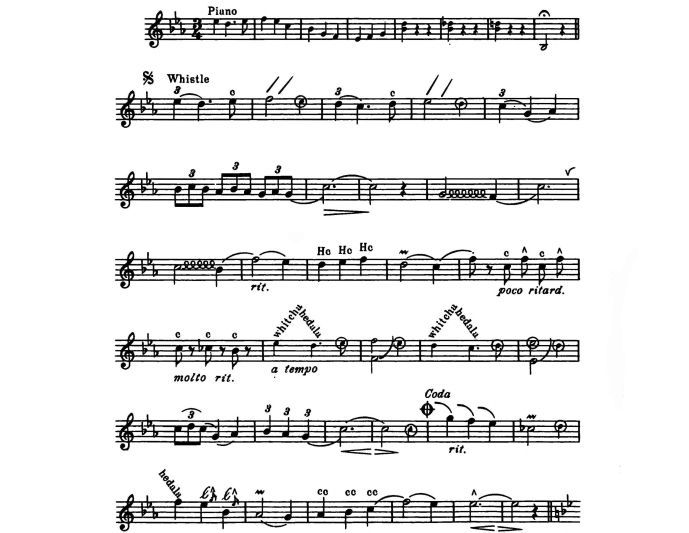
[Listen]
Copyright MCMXVII by M. Witmark & Sons, New York. Used by permission.
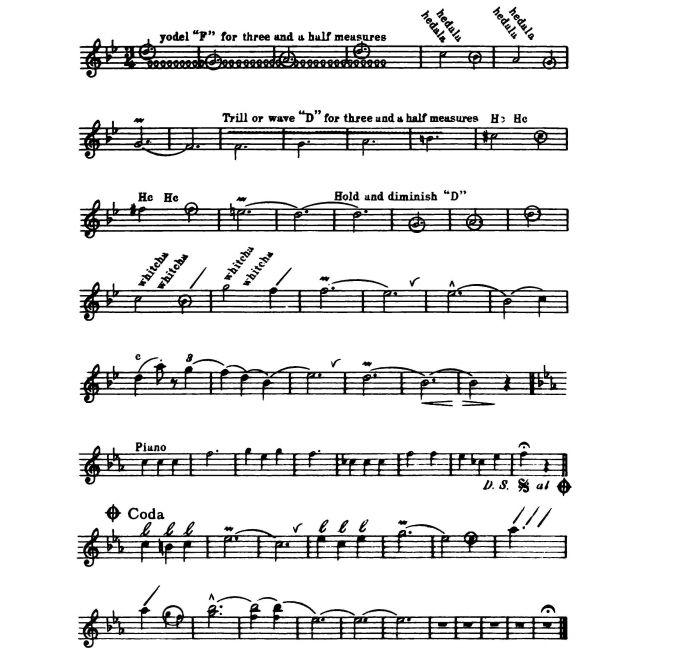
Key to “ ’NEATH THE AUTUMN MOON” (Vanderpool)
Key of E flat
Whistle a smooth triplet on the first note and from it glide to the next note. Let go quickly. Whistle a short chirp on “E flat” and follow in next measure with two whips on the first and second beats. Repeat idea for next two measures. Whistle a smooth triplet on “C” and slide to next two notes. Now take a group of smooth triplets on the notes indicated, and from the last group whistle smoothly to the dotted half note in next measure. Yodel “G” into “F” and slide smoothly to upper note. Repeat idea with changed pitches. If however this yodel is too high for whistler, substitute the wave. Now whistle bright “hewie chirps” on three even beats, (pitches of first “hewie” being from “D” to “F”, second “E flat” to “F” and third “F” to “B♭”). Mordent “D” and slide over smoothly to the next two notes, letting go quickly of the high “F”, and taking the little chirped effect indicated,—a chirp on “C”, a staccato on “F,” another chirp on “C” followed by another staccato on “F”, and in next measure a short chirp on each of the three pronounced melody notes in the accompaniment (the first chirp on “C”, the second one on “C flat” and the third one on “B flat”.) Observe a decided ritard here. Again take up original theme but with changed markings, whistling “whitcha” on first beat, and “hedala” on second beat (the third beat being a rest for the whistler.) In following measure, whistle an “upward cry” from the pitch of “F” (first space), feathering off an octave above (this figure filling the measure.) Repeat bird figures in next measure (as just explained) and follow with an “upward cry” (this time from the pitch of “E flat”.) Again whistle a smooth triplet and follow in next measure with triplets on the melody notes. Now come three “downward cries”. These may all be taken from the pitch of high “G” or may follow the melody notes, the first one from “G”, the second one from “F” and the third one from “E flat”. Follow with a mordent on “C flat” (omitting circled note). Now come more bird figures, a “hedala” on high “F” (starting from the note) a “lup-ee” (pitches “E flat” to “G”) on second beat, and another “lup-ee” (pitches “B flat” to “E flat”) on third beat. Mordent “A flat” and glide to next note. Then whistle double chirps to each of the three notes in following measure, two chirps on “A flat”, two on “B flat”, and two on “C”, (treating all as even 8th notes.) Swing from last chirp to high “F” and over smoothly to following notes, being sure to strike the last “E flat” a second time, as indicated. Otherwise the “E flat” (quarter note) would sound as though tied to “E flat” (dotted half note).
Now, with change of key to “B flat” while accompaniment takes the melody, whistle a continuous yodel on the pitch of “F”. Follow this with two “hedalas”, the first one on the first beat, the second one on the second beat. Keep high. Repeat idea. Third beat in each measure is a rest for the whistler. Then mordent “G” and slide smoothly to “F”. Now trill (or wave) “D” on fourth line for three and a half measures, while accompaniment takes melody notes. Follow with groups of “hewies” on the first two beats of each measure, the pitches of the first group being “C♯” to “E♯”, and the second group “C♯” to “F♯” Mordent “E natural” and slide to “D”, holding this as long as possible, and making a fine diminuendo. Now take up the brilliant “whitcha” measures, making the figures high, and follow each second “whitcha” with a whip. The balance of the phrase is easy to decipher. After a piano interlude of eight measures, take up second verse with same markings as first, although the ending is somewhat different. Here whistle a clear “lup” to each of the quarter notes, exactly on pitch, and in the measures indicated. Where “whips” are written, whistle these with force and brilliancy, broad and full (having accompanist make decided allargando here). Omit circled notes (these are in accompaniment), and strike high B flat, holding full value, and swing to final note (E flat) and hold as long as possible. If “B flat” is too high, take lower notes written in music.
FRED G. ALBERS
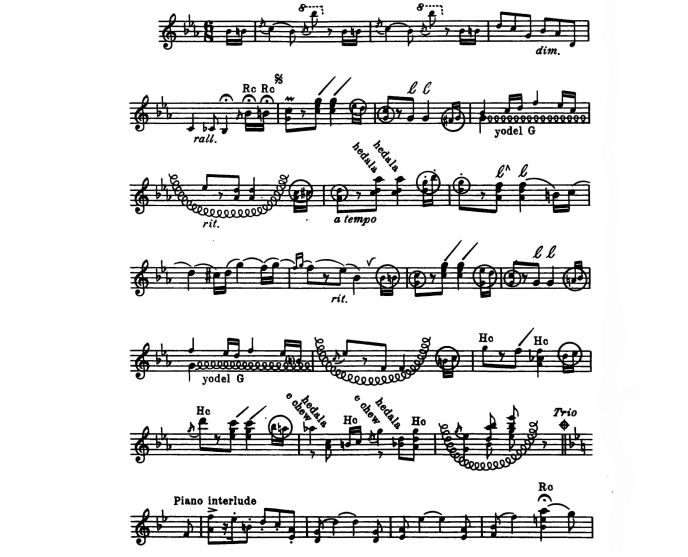
[Listen]
Copyright MCMXIV by Sam Fox Pub. Co., Cleveland Ohio. Used by permission.
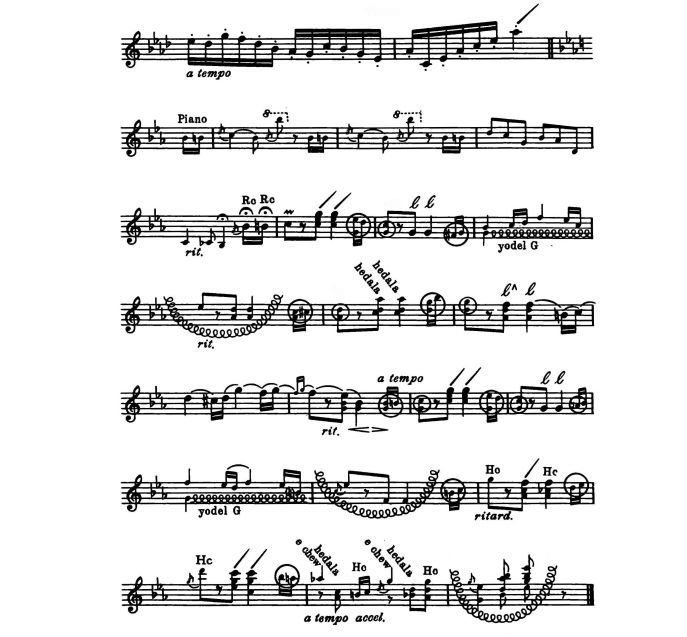
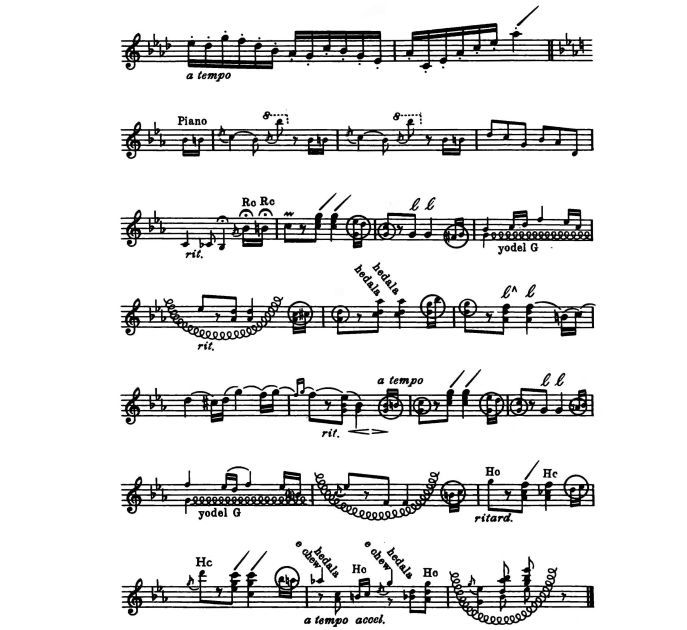
Key to “IN POPPYLAND” (Albers)
Pianist plays an introduction of four measures, at the conclusion of which the whistler commences on the sixteenth notes with “reverse chirps” (“G” to “B flat” and “G” to “B natural”), observing the holds in both cases. Then take up brightly the figures which follow, a mordent on “C” followed by two “whips” on high “G”. Omit next three notes. These are played by pianist. Then whistle two short “lups” on the pitch of “G”, and follow in next measure with a yodel on same pitch, and in the succeeding measure a dipped yodel.
Now allow pianist to take the first beat of the following measure, and whistler continues with two “hedalas”, the first one coming on the third beat and the next one on the fourth beat (this of course counting six beats to the measure). All circled notes are omitted by whistler. In the measure following, whistle a quick “lup-ee” (pitches “F” to “A flat”) on the third beat; a single “lup” on the fourth beat (which is held), and from which the whistler carries the melody down and up again as written, continuing for two measures. Next four measures are like original ones at commencement of selection.
Now comes a bright “hewie chirp” on the first beat, (pitches “C” to “G”), followed by a dashing “whip” on the third beat, and a final “hewie chirp” on the fourth beat (pitches “C flat” to “F”), the balance of the measure being a rest for the whistler. Repeat idea in following measure, the pitches of the “hewie chirp” in this case being from “E flat” to “G”. The next two measures are taken very rapidly, whistling a bird figure to each of the six even beats. In other words, whistle an “e-chew” to the first beat, a “hedala” to the second beat, and a “hewie chirp” to the third beat, repeating same figures for the last three counts of the measure. End the phrase with a “dipped yodel”, whistling this very quickly so that both whistler and accompanist will end together.
Following an interlude of about four measures, the whistler strikes a high “reverse chirp” on “A”, sliding over to “G”. Then whistle a bright “hewie chirp” (pitches “C” to “F”), follow with “lups” on exact pitches of the notes written, whistling another quick “hewie chirp” on the pitch of “D” (as indicated). The last two beats are a rest for the whistler. Yodel the pitch of “G” for one measure, continuing into the next measure with a change of pitch to “A”. Piano now has an interlude of one measure, when whistler takes up more interpolative work,—a “whip” on the first beat, a “chirp” on the last half of the second beat, another dashing “whip” on the third beat, and close the measure with two short chirps on the fourth and fifth beats on the pitches written. Last beat is omitted. In following measure repeat idea using same markings. Then whistle a succession of staccatos on the pitch of “A” in the one measure, continuing into next measure but with the pitch changed to “B flat”. End the phrase with the smooth melody as written. Take breath where indicated, and close the theme with the melody, making a decided crescendo and diminuendo on “B flat”. The balance of the phrase is taken by the pianist. The original theme is now taken up and dealt with in like manner.
TRIO. (Key of “A flat”).
After a piano interlude of two measures, whistle the melody smoothly, observing the “reverse chirp” and the mordent. Then whistle three bright “hewie chirps” (one to each 8th note) and follow with double chirps on each of the remaining 8th notes. The pitches of the “hewie chirps” are from “E flat” in each case up to the upper note in each chord. The double chirps follow, pitches “E flat” and “C”, two chirps to each 8th note. The “whit-cha-koo” is made on exact pitches, the “whip” on “G”, the “cha” (hew) on “F”, and the “Koo” on lower “G”. Hold this last note full value. Follow this in next measure with an “upward cry” starting from the pitch of “C” and covering three beats, and another “upward cry” starting from “D flat”, covering the last three beats. Next, allow a pathetic “downward cry” to fill the entire measure, and follow this with a piano interlude of two measures. Again whistle the melody smoothly, observing the “reverse chirp” and the mordent.
Now come two “hedalas”, one on each of the first two beats, whistler omits third beat. The “upward cry” starting from the pitch of “G” (2nd line) completes the last three beats. The first “whitcha” in next measure comes on the first beat, the second “whitcha” on the second beat, a “whip” on the third beat, and a “downward cry” covering the last three beats. End with the staccato run as written, and a dashing “whip” on last note. Balance of selection as before.
LEE ROBERTS
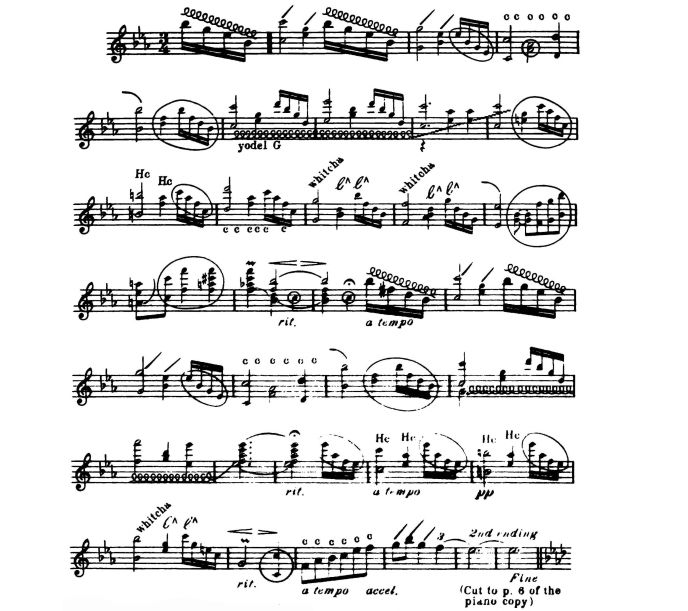
[Listen]
Copyright MCMXXII by Lee S. Roberts.
Copyright transferred MCMXVIII to Forster Music Publisher, Inc., Chicago, Ill. Used by permission.
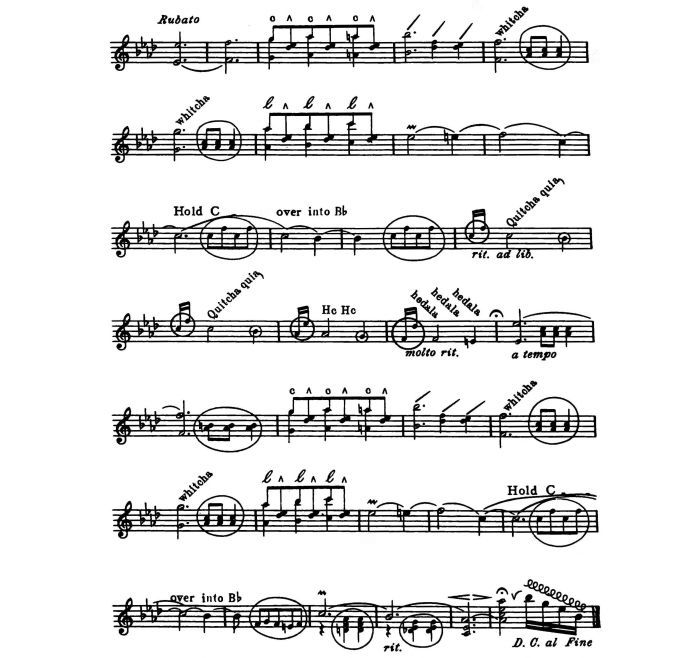
Key to “VALSE PARISIENNE” (Roberts)
Whistle a “descending yodel” on the first four notes. If unable to yodel, whistle a “hedala”, and let go at once, striking the two brilliant “whips” in the next measure on the first and second beats. Repeat idea for the next two measures, omitting the four notes bracketed. Then follow with six even chirps, two to each count (four being on the pitch of “C” and two on the pitch of “D”). A “downward cry” fills the entire measure after this. In the next measure, commence a yodel on “G” (2nd line) and continue for two measures, quivering up and out of the yodel to a delicately feathered effect in the second measure beyond. Omit all bracketed notes. The accompanist will play these. Whistle two “hewie chirps” (pitches “B natural” to “F”) on the first and second beats. Following this, six low chirps are to be made on the pitch of “C” (added line below) and on the even beats. Then follow in next measure with a “whitcha” on the first beat, a “lup-ee” on the second beat, and another “lup-ee” on the third beat, (the lup-ees in both cases being on the pitches of “B flat” to “D”). Repeat same figures in next measure and follow with a “downward cry”. In the following measure whistle an “upward cry”, starting from “A natural”, and feather off quickly and softly. Then “mordent” on the high “F”, slide down to “B flat”, hold this into the next measure, making a decided crescendo and diminuendo on this note.
Again take up the original theme and treat in similar manner. Where the yodel is expressed on “G”, continue for two measures and slide up out of this pitch into “E flat” (fourth space), holding sufficiently long to make an effective ritard. Then take up the “hewie” measures, making the first group from the pitch of “C” to “E flat”, and the second group from “B natural” to “E flat”. Follow with a “whitcha” on the first beat, two “lup-ees” (one each) on the second and third beats, (these being from the pitches of “B flat” to “E flat”.) Then take a mordent (with crescendo and diminuendo) on the pitch of “G”. In the next measure, follow the melody on the lower notes with chirps, ending the line with three “whips” on the two 8th notes and the quarter note, a “triplet” on “F”, and a direct slide to the final note of “E flat”. Take second ending. Note that in the making of the “whips”, the first two are much quicker than the last one.
Eighty measures of the original are here omitted. (Pianist turns to page 6).
Take up rubato passage as follows;—whistle smoothly from “E flat” to “F” (lower notes), and then take “chut-ees” on the three even beats (with pitches each time from “E flat” to the pitch of the upper note just preceding), remembering that a “chut-ee” is nothing but a chirp followed by a staccato note. Continue with three brilliant “whips” on three even beats. In the next two measures whistle a bright “whitcha” on the first beat of each measure, respectively on the pitches of “F” and “G”, the “cha” (hew) on the pitch of “C”. Following these “whit-chas” whistle three even “lup-ees” (a “lup” and a staccato) on the pitches of “D flat” to “E flat”. Then mordent “E flat” and whistle smoothly to “E natural” and over to “F”, treating this note as a half note, and sliding down to the pitch of “C” and “B flat”, thus covering three measures. In the measure following, whistle a quick “quitchaquia” with a decided accent on the syllable “qui”. Whistle also another “quitchaquia” in the next measure. Allow a little drop in sound at the end of each figure. Now come two bright “hewie chirps” on the first and second beats, going from pitches of “A flat” to “E flat”. In next measure whistle three even “hedalas”, (pitches “E flat” down to “D flat” and further down to “B flat” on third line). Observe a decided ritard throughout these four measures. Now take up the previous theme, with original tempo, and close the motive with the last three notes taken smoothly, whistling connectedly from the “C” (on which is a mordent over to “B flat” and on into “A flat”).
Hold last note its full value. The balance of selection is like original theme.
| Words by | Music by | |
| IONA LE BRUN | MARY HELEN BROWN |
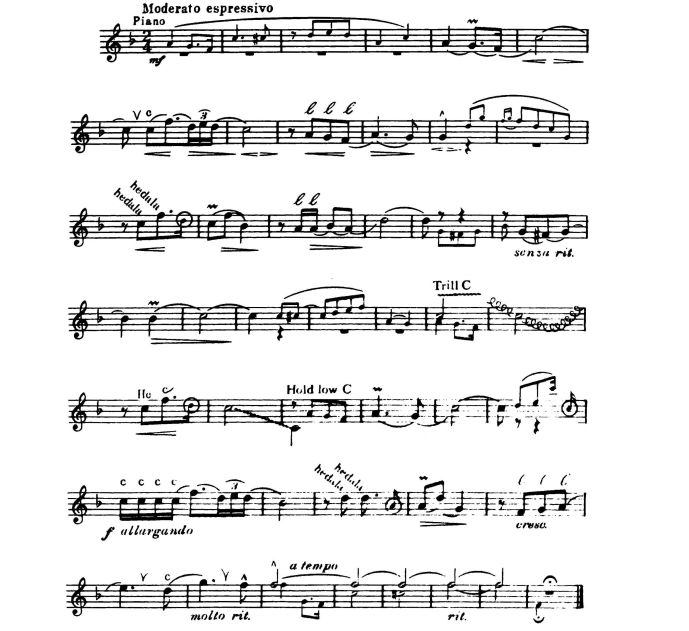
[Listen]
Copyright 1921 by Huntzinger & Dilworth, Inc. (R. L. Huntzinger, Inc., New York) Used by permission.
Key to “God Touched the Rose” (Brown)
Pianist plays an introduction of four measures.
Whistler commences with the plain note (A) gliding to following note which is mordented, and on over to the notes following. Make a decided swell on the “C”. Take breath. Catch the next note with a chirp (“hew” sound) and glide smoothly to the high note; over to the even triplet; and on to the “C”. Swell on this note.
In the third measure of the 2nd line whistle a “lup” on each of the notes indicated, going smoothly from the last one to the notes following, making a swell and diminuendo on the last note.
Now whistle the two “hedalas”, the first one commencing on “C” and covering the descending pitches “C, A, F”; and the second “hedala” covering “F, D, A”. Do not whistle these figures rapidly but rather “draw” on the first syllable. Omit circled note. Mordent on “C” in following measure, glide up on the same beat to the high “F”, and down again to B flat; and in next measure, after whistling two quick “lups” on the “A”, continue the melody smoothly as indicated. If desired the final note here (“D”) may be taken in a succession of staccatos. The balance of first verse is easy to decipher. Whistle smoothly, and glide to “C” as the final note. Allow tone to die away to a mere breath. In the 2nd verse trill the pitch of “C” for the one measure, and complete the phrase with a “dipped yodel”. Feather off sweetly. In the following measure, after whistling the “hewie chirp” on the first note, whistle a chirp (“hew” sound) on the high “F” and allow an ascending cry to feather off delicately. Omit circled note. Then quiver down from “C” (half note) to low “C” in next measure, and hold this pitch throughout the measure.
Mordent the “A” and swing smoothly to notes following. Diminish the tone on last note. In the first measure of the 6th line, whistle four even chirps (16th notes) and swing from the last chirp to the high “F”; over on the smooth triplet and on to the half note.
Whistle the “hedalas” from the pitch of “D” drawing with a pronounced pressure on the first syllable. Then omitting the circled note, mordent the “A” in following measure, and swing smoothly up to “D” and down to the “G”. Follow the “lups” on pitches indicated, swinging smoothly from the last “lup” to the note in line below. Catch breath. Then with a chirp on the “D” (and this should not be a sharp chirp, but a subdued one) swing to the high “G”; hold required time; and strike the “F natural” (last note in measure), and again striking the same pitch, hold as long as possible, or until completion of accompaniment.
Words and Music by
SEPTIMUS WINNER
(Alice Hawthorne)
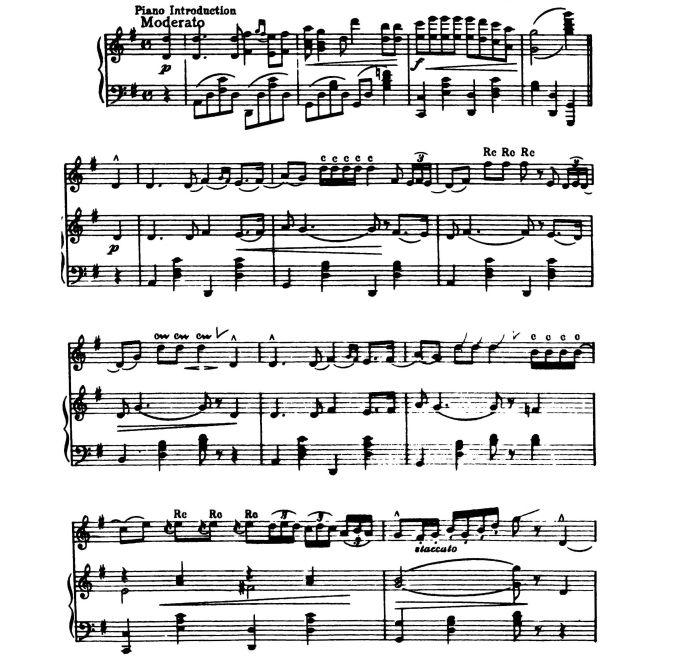
[Listen]
Copyright MCMVI by Century Music Pub. Co., New York. Used by permission.
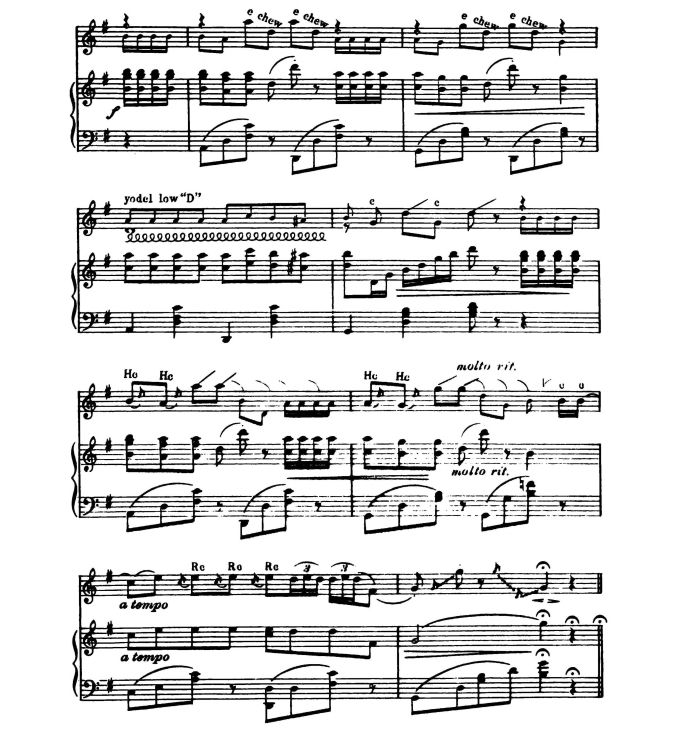
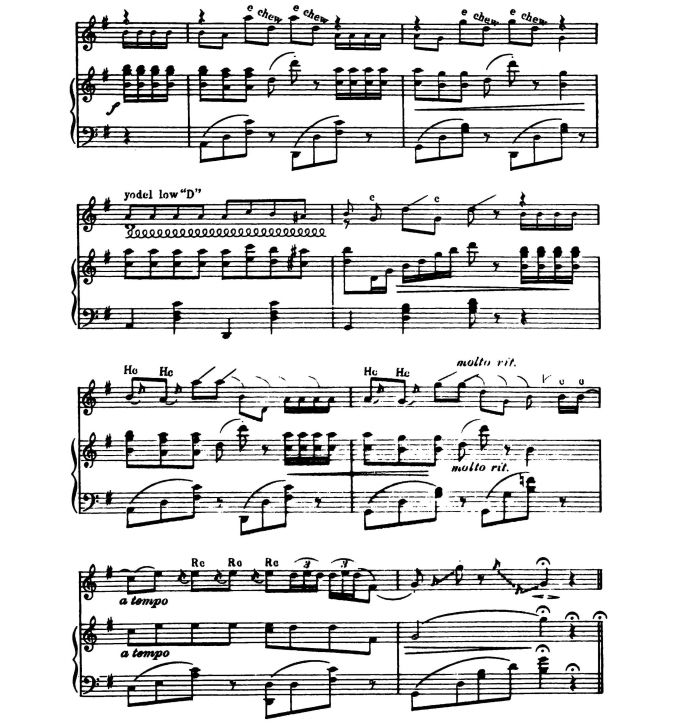
Whistler now gives the following bird imitations without piano accompaniment.
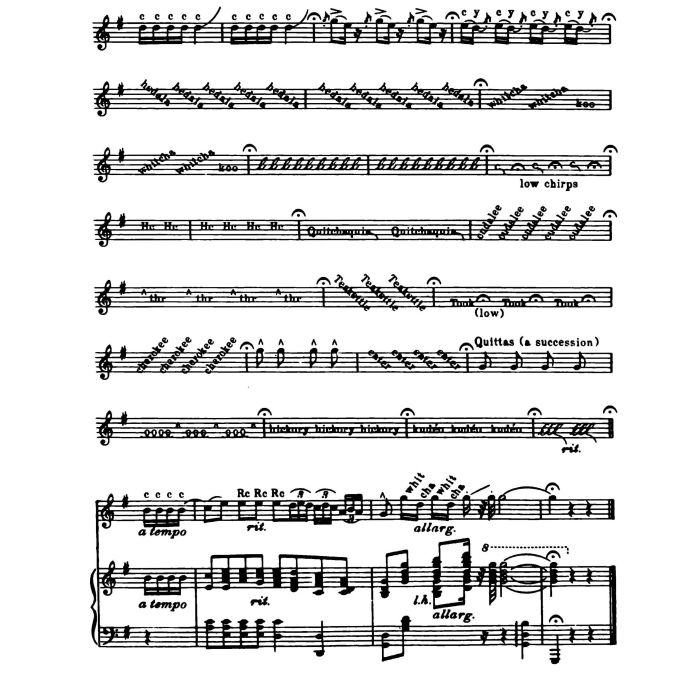
Key to “Listen to the Mocking Bird” (Winner)
Key of G
Accompanist plays an introduction of four measures, first two and last two on first page of sheet music.
Whistler commences with a plain note on “D”, again whistling in next measure the same pitch, then continues with the melody smoothly as written, observing the two little staccato grace notes; and in the measure beyond, on the second beat whistle four short chirps, allowing a fifth chirp from which an upward cry ascends, to be given on the third beat. Again the smooth melody is taken up, a triplet being whistled on the 16th note and from it glide to the first two notes of the following measure. On the second beat whistle two “reverse chirps” and a third “reverse chirp” on the third beat. Again the melody, and treat as before. On the second beat of the following measure, two chirped mordents are given, and a third chirped mordent given on the third beat. This is held a trifle and a slight swell observed. Again the melody is taken as before, and on the second beat of the measure following, two “upward cries” are given, a third one on the third beat. Then the four short chirps are whistled on the fourth beat, and from the last chirp glide smoothly to “C” and up to “E”. Follow the markings as given, observing that the triplets are all smooth; and in the measure beyond a bright staccato run is given, dashing off with a brilliant whip. Now strike low “D”, hold, and glide into a whistled yodel on the same pitch, continuing this figure into the neat measure. After the first beat which is yodeled, whistle two quick “hedalas” on the second beat, and a third “hedala” on the third beat. After the piano plays the small notes, then in the following measure, three “whitcha” figures will be whistled, two on the second, and one on the third beat. Remember here too that the “whit-cha” is simply a combination of a “whip” and a “chirp”, and should be whistled “whee-hew”. Do not be too literal on this figure. The bird sings “whitcha”, hence its name; but the human whistler must remember to whistle “whee-hew” to imitate the bird exactly.
In the next measure, a quivering effect is given from “D” to high “G” and back again to “D”; the first occurring on the second beat, and the second one on the third beat. The effect is almost like a staccato chromatic run from “D” to “G” and back again to “D”. It is whistled very quickly. The plain note at end of measure may or may not be taken, according to the option of the whistler.
Trill “D” for one measure while accompanist plays the melody. In next measure whistle two “downward cries” on first beat; a rest and the “Bob” (a short staccato note) on second beat; and the “whip” (“White”) on the third beat. Then again take up the four short chirps and continue as previously explained. End the line with an ascending quiver from the “G”, up an octave. Feather off exactly with the time of the accompanist.
On page 119 (1st line), after a piano interlude of six notes, whistle the first “e-chew” (e-hew) on the second beat (even 8th notes); and follow with another similar figure on the 3rd beat. Repeat idea in the measure beyond. Omit small note.
2nd line: Yodel low “D” for one measure. In measure beyond, on the last half of the first beat whistle a short chirp, and follow this with a bright “whip” on the first half of the 2nd beat and another short chirp to complete the 2nd beat. A last “whip” covers the third beat. Fourth beat is a rest to the whistler.
3rd line: Whistle two bright “hewies” on the pitches given, on the first beat; two brilliant “whips” on the second beat; two “downward cries” (from high “A”) on the third beat, and two more “downward cries” on the fourth beat. Repeat idea in measure beyond, but note that the “downward cries” are from high “G”. The fourth beat is composed of one “downward cry” and the two short chirps. Allow a decided ritard to occur here in order to give whistler sufficient time to take a catch breath before the two chirps. Then from the second chirp of the two, slide smoothly to the melody on next line. Treat as before. In the last measure of line, after touching the “G” staccato, quiver up from the same pitch to high “G”; letting go of this note immediately; and from the same pitch take a quick descending quiver down past the second line to the low “D” and back up again to that particular note—“G”. If the whistler is able to introduce a portion of the yodel in the descending quiver, before it reaches the low “D” and up and around to the final note, so much the better. Hold the last note and make a decided crescendo and diminuendo.
On the next page comes a varied grouping of bird figures which the whistler does independently without piano accompaniment. All figures have been previously explained in the book.
At the close of the bird imitations, (the two slowly whistled “lups” with a drop at the end of each group) the accompanist plays with the whistler the four short chirps, and the selection is finished as written. Whistler holds the final note as long as accompanist sustains the chord. If desired the accompanist may add an arpeggio up and down the piano. The effect must be grandioso and brilliant.
FRITZ KREISLER
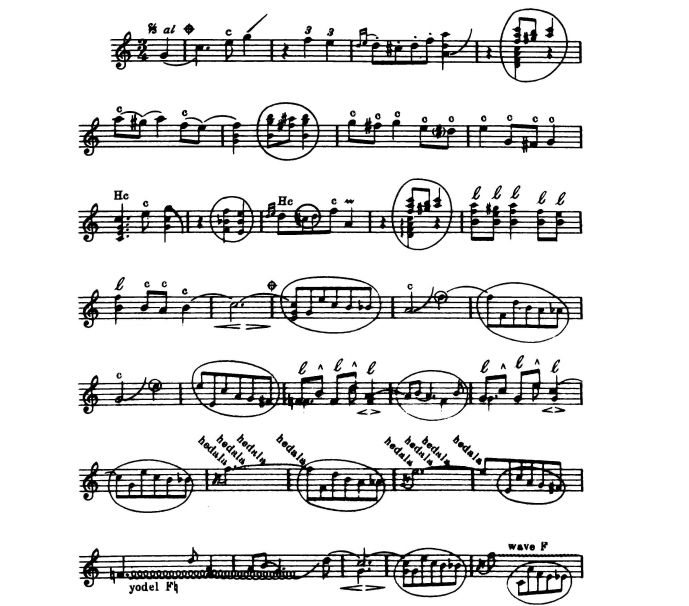
[Listen]
Copyright MCMXI by Carl Fischer, Inc., N.Y. Used by permission.
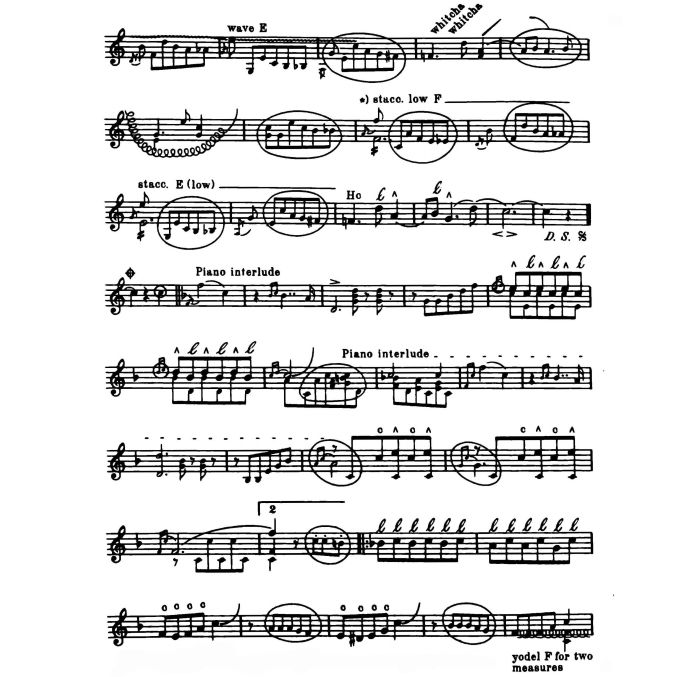
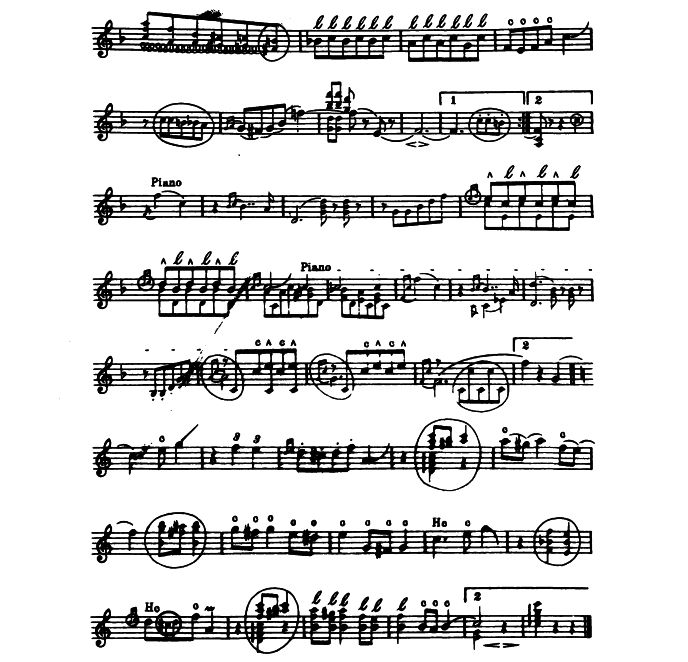
[9] The staccatos as rapidly as possible, not necessarily in time.
Key to “LIEBESFREUD’ ” (Kreisler)
Whistle smoothly from the first note to the one in the next measure. Then give a short chirp on the pitch indicated, and dash off a “whip” on the last note. Observe rest, and follow with triplets on the exact pitches written. Now follow the staccato melody, and end with an “upward cry” feathered out from “A” (second space). Omit all circled phrases. Whistle the high “chirp” and slide from it to the notes following, observing also the second chirped group, and the chirps written above every note in the next two measures. Chirp each one on exact pitch. Then whistle a bright and short “hewie chirp” on “C”, a single “chirp” on “E”, and a “downward cry” from “G”. In the second measure beyond, again whistle a bright “hewie chirp” on the first note (omitting next two notes), a “chirp” on high “F” and a mordent on “A” (second space). Omit notes circled in next measure, and then follow with the “lups” on each note (as indicated), and all of them on the pitch of “B” (3rd line). The three short chirps are taken on the exact note pitches, and from the last one slide smoothly to “C” in the next measure. Make a decided crescendo and diminuendo here. Take second ending, piano playing the few introductory notes. Now whistle a “chirp” on the pitch of “A” (2nd space), holding it and smoothly gliding up on the third beat and feathering off in an upward cry. After another measure of circled notes, again whistle a “chirp” on the pitch of “G” (2nd line) and glide up in an “upward cry” as just previously explained.
After another measure of circled notes, whistle a “lup” on “F natural”, a staccato on “B”, another “lup” on “F natural”, a staccato on “D”, and a last “lup” on “A”, holding this last note long enough to make a slight swell. In the second measure beyond, the same idea is again carried out, the pitches in this case being “G” to “C”, “G” to “E”, and the final “lup” on “C”. This last note is also held and a crescendo and diminuendo given at this point. After another measure of circled notes, whistle four even “hedalas”, three on the three even beats in the one measure, and the fourth “hedala” on the first beat of the following measure. Repeat idea in the second measure beyond. The yodel which now comes, is taken on the pitch of “F natural” and continued for nearly two full measures, swinging to the last note in the second measure (“D”) and on over smoothly to the half note (“C”). Hold and make a crescendo and diminuendo. Wave (or trill) high “F” for two measures, continuing the wave for two more measures but with the pitch changed to “E”. Whistle the “whitcha, whitcha, whip” on the three even beats (no pitch indicated, but taken high), follow with a “downward cry” in the next measure, and a “dipped yodel” in the measure beyond. Start the yodel high, continuing down and back again, and feather off in the following measure with “upward cry”. Now staccato “F” for two measures,—(as many staccatos as is possible to whistle rapidly in each measure), continuing two more measures, but with the pitch changed to “E”. Whistle a bright “hewie chirp”, pitch “F” to “D”, a “lup” on “D” and a plain tone on “A”. In next measure omit the tied note, and whistle a “lup” on “B”, a plain tone on “G” and over smoothly to “D” and “C”, making a swell on the last note. Now comes the original theme again, (D. S.). Treat in same manner as before. From the sign ⌖ go to Key of “F” (one flat). After a piano interlude of four measures, whistle a group of “E-lups”, one to each of the three beats, the staccato coming on the pitch of “E” and the “lup” on the pitch of “C”. Repeat idea in next measure, but with pitches changed to “D” and “B flat”. Whistle grace notes in next measure and from “C” glide smoothly upward in an “upward cry”. After another piano interlude of five measures (and the first beat in the following measure omitted); whistle two groups of “chut-ees” one on the 2nd beat and the other on the 3rd beat, with pitches in each case “C” to “E”. Repeat idea in next measure. Then whistle smoothly the grace notes preceding “F”, and glide from this note up an octave to high “F” in the following measure. Take second ending. Now whistle a “lup” to every note in the next two measures and on exact pitches. Follow chirps also on pitches, and feather out sweetly from the last note of the measure in an “upward cry”. Yodel on “F” for nearly two measures, and again take up the “lup” measures and treat in same way. End smoothly as written, holding high “F” from the last beat of the one measure to the third beat of the following measure, when it drops down smoothly to “E” (1st line), and continues smoothly to the last note “F” (which is held and a swell given at this point).
The balance of the selection has same markings as previously explained. Treat in same way.
End the selection (2nd ending) on “C”, holding and making a crescendo and diminuendo.
————
WHISTLING CHART WITH SYMBOLS
The characters below will give the reader an idea of the markings employed in the various whistling selections.
The lines indicate braces, the squares represent measures, and the different characters symbolize the various strokes of the tongue. The circles indicate silence for the whistler.
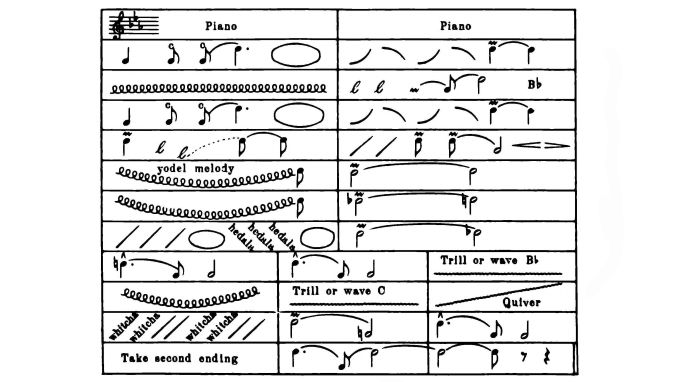
Similar charts as the above may be drafted for all compositions, using the symbols only. Where the music is known or may be played in class work, these diagrams may be put on the blackboard and copied by the pupils.
Copyright MCMXIX by Francis, Day & Hunter.
T. B. Harms and Francis, Day & Hunter, N.Y. International Copyright Secured. Used by permission.
CHOPIN
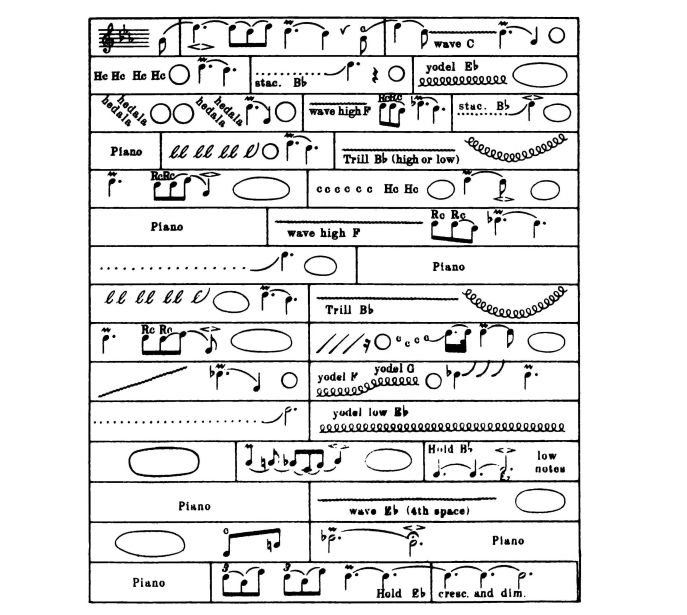
Recitation with Bird Notes Interpolated
(for encore)
“Do you know what I heard one morning
As I gazed on the glistening dew?
Oh! ’twas a wonderful secret,—
But if you listen, I’ll tell it to you.
Sweetly and softly the meadow-lark told me—

But quick from the hillside the ring-dove denied!

Then a mocking bird in a tree close by,
Heard the remark and made reply—

Then my canary at the window
Spoke so plaintively to me;—

That I opened wide his cage,
And quickly set him free.
But ere he sped to join the songsters,
He sang quite joyously—

Have you guessed the secret that they bring?
No? Why guess, and guess again.
Don’t you know when birds just sing, and sing, and sing,
They mean it’s Spring; it’s Spring; it’s Spring!”

KEY TO BIRD NOTES AND SONGS IN “BIRD SECRETS”

[Listen]

[Listen]

[Listen]

[Listen]

[Listen]

[Listen]

[Listen]
Recitation (or pianologue) with bird notes interpolated
(Piano introduction of four measures)
Two little magpies sat upon a rail;
It might have been a Wednesday week:—

[Listen]
When one little magpie rubbed his tail—⩀ℓℓ ℓ◝
’Gainst the other little magpie’s beak;—whee

[Listen]
Said that little magpie to the other,
“Well, really upon my word! c c◝
It’s more than flesh and blood can stand, whew ew/
From a magpie, or any other bird; K ℓ◝
From a magpie, or any other bird;” K ℓ◝ K ℓ◝
So they fought—quit
And they fit—◝
And they scratched—thr◝ thr◝
And they bit—c⌃ c⌃ c⌃
’Till all that was left upon the rail, ◝
Was the beak of one of those little magpies, whee
And the other little magpie’s tail:—

[Listen]
Copyright MCMXXIII by The Boston Music Company. Used by permission.
Key to bird interpolations in “Two Little Magpies”
At the end of the first two lines (following the word “week”) whistle the staccato run as written, omitting the first two notes which are circled. The accompanist plays these.
Bird figures in the order in which they occur

[Listen]


[Listen]

[Listen]

[Listen]


[Listen]

[Listen]

[Listen]

[Listen]

After the word “tail”, whistle staccato run as written, dashing off with a brilliant “whip”.
Partial List of Songs and Instrumental Selections used at the Agnes Woodward School of Whistling in Los Angeles, adapted to whistling, when marked with the symbols used in the “Woodward Method of Bird Whistling.”
| TITLE | COMPOSER | PUBLISHER |
| Absent | Metcalf | Arthur P. Schmidt Co. |
| Adieu | Friml | The Boston Music Co. |
| Admiration | Jackson | Sam Fox, Cleveland |
| Ah! I have sighed to rest me, (fr. Opera “Il Trovatore”) | Verdi | Carl Fischer, Inc., N.Y. |
| Ah! Moon of my Delight (fr. Persian Garden) | Lehmann | Boston Music Co. |
| Alba (fr. Venetian Suite) | Nevin | John Church Co. |
| Allah’s Holiday | Friml | G. Schirmer |
| Amorette | Krogmann | B. F. Wood Music Co. |
| Amorita | Grunn | So. Calif. Music Co. L.A. |
| Annie Laurie | Lehmann | Chappell-Harms Co. N.Y. |
| Anitra’s Dance (“Peer Gynt”) | Grieg | Carl Fischer, Inc. |
| At Dawning | Cadman | Oliver Ditson, Boston. |
| At Parting | Rogers | G. Schirmer |
| Ave Maria | Gounod | Carl Fischer, Inc. |
| Barcarolle (fr. Tales of Hoffman) | Offenbach | Carl Fischer, Inc. |
| Beautiful Isle of Somewhere | Fearis | Forster Music Pub. Chicago. |
| Believe me if all those endearing Young Charms | (old Irish) | G. Schirmer (Century) |
| Berceuse (fr. Jocelyn) | Godard | Carl Fischer, Inc. |
| Bird of Love Divine | Wood | Boosey & Co. |
| Bird Raptures | Schneider | Clayton Sammy, Chicago |
| Birds and the Brook (The) | Stults | Brooks & Denton, N.Y. |
| Bluebird (The) | Kummer | Jerome Remick Co. N.Y. |
| Blackbird and Throstle (The) | Borsdorf | Boosey & Co. |
| Bubble (The) (fr. “High Jinks”) | Friml | G. Schirmer |
| Buona Notte (fr. Venetian Suite) | Nevin | John Church Co. |
| By the Silvery Nile | Johnson | Forster Music Pub. |
| By the Waters of Minnetonka | Lieurance | Theo. Presser |
| Canzone Amorosa (fr. Venetian Suite) | Nevin | John Church Co. |
| Can’t Yo’ Heah Me Callin’, Caroline? | Roma | M. Witmark & Sons, N.Y. |
| Carita | Winne | Jerome Remick & Co. |
| Carry me back to Old Virginny | Bland | Oliver Ditson |
| Carry the Cross | Galbraith | A. P. Schmidt |
| Caprice Viennois | Kreisler | Carl Fischer, Inc. |
| Chanson | Friml | G. Schirmer |
| Charm of Spring (The) | Clarke | Chappell-Harms Co. N. Y. |
| Chimney Swallows | Bond | Schuberth Music Co. |
| Chinese Lullaby (fr. “East is West”) | Bowers | G. Schirmer |
| Come for it’s June | Forster | Sam Fox Pub. Co. |
| Comin’ Thro’ the Rye | Meacham | Century Music Co. |
| Crying of Water (The) | Campbell-Tipton | G. Schirmer, Inc. |
| Dance Caprice | Grieg | Carl Fischer, Inc. |
| Dancing Leaves | Miles | Sam Fox Music Pub. |
| Dawn of Love | Friml | G. Schirmer |
| Dear Little Boy of Mine | Ball | M. Witmark & Sons. N.Y. |
| Dolores | Grunn | Theo. Presser |
| Dragon-fly, (The) | Smith | Sam Fox Music Pub. |
| Dream (A) | Bartlett | Oliver Ditson |
| Dream of Paradise (A) | Gray | Carl Fischer, Inc. |
| Dreaming Alone in the Twilight | Moore | Oliver Ditson |
| Ecstacy (An) | Stoughton | Oliver Ditson |
| Eleanor | Deppen | Sam Fox Music Pub. |
| Evensong | Martin | Chappell-Harms Co. |
| Face to Face | Johnson | Waldo Pub. Co. |
| Father’s Song | Fuller | Fuller, Los Angeles |
| Fawn (The) | King | Leo Feist N.Y. |
| Four Little Blackberries | O’Connor | Leo Feist |
| Forest Song | Whelpley | Boston Music Co. |
| From the Land of the Skyblue Water | Cadman | G. Schirmer |
| Garden Dance (A) | Vargas | Sam Fox Music Pub. |
| Gipsy Card-Song | Mildenberg | G. Schirmer |
| Gipsy Love-Song | Herbert | M. Witmark & Sons. |
| Ghost Dance (The) | Salisbury | Will Rossiter, Chicago |
| Giannina Mia (fr. Opera “The Firefly”) | Friml | G. Schirmer |
| Glow-worm (The) | Lincke | Ed. W. Marks Co. |
| God Touched the Rose | Brown | G. Schirmer |
| Gondoliers (fr. Venetian Suite) | Nevin | John Church Co. |
| Gray Morn | Standish-Ward | Forster Music Pub. |
| Haymaking | Needham | Boosey & Co. |
| Hosanna | Granier | Carl Fischer, Inc. |
| Humoresque | Dvorak | Carl Fischer, Inc. |
| Hungarian Dance No. 5 | Brahms | Carl Fischer, Inc. |
| I Hear a Thrush at Eve | Cadman | White-Smith Co. |
| Il Cammino | Fuller | Fuller, Los Angeles. |
| Indian Love-Song | Grunn | So. Calif. Music Co. L.A. |
| In Poppyland | Albers | Sam Fox Music Pub. |
| In Springtime | Grunn | So. Calif. Music Co. |
| Interlude (An) | Ronald | Enoch & Sons. N.Y. |
| Invitation | Owen | M. Witmark & Sons. |
| Japanese Sunset | Deppen | Sam Fox Music Pub. |
| Just an Old Love Song | Schertzinger | Sherman & Clay S.F. |
| Just A’wearyin’ for You | Bond | The Boston Music Co. |
| Just to Hear You Whisper | Penn | M. Witmark & Sons. |
| Kashmiri Song (fr. Indian Love Lyrics) | Finden | Boosey Music Co. |
| Kiss Me Again (fr. Opera “Mlle Modiste”) | Herbert | M. Witmark & Sons. |
| Kiss (The) | Arditi | Carl Fischer, Inc. |
| La Capricieuse | Eggling | G. Schirmer |
| La Donna e Mobile (fr. “Rigoletto”) | Verdi | Carl Fischer, Inc. |
| La Paloma | Yradier | Carl Fischer, Inc. |
| Les Myrtes | Wachs | Carl Fischer, Inc. |
| Les Sylphes | Bachmann | Carl Fischer, Inc. |
| Less than Dust (fr. Indian Love Lyrics) | Finden | Boosey & Co. |
| Liebesfreud’ | Kreisler | Carl Fischer, Inc. |
| Liebestraume | Lizst | Carl Fischer, Inc. |
| Listen to the Mocking Bird | Winner | Century Music Co. |
| Love Letters | Jackson | Sam Fox Pub. Co. |
| Love Sends a Little Gift of Roses | Openshaw | Chappell-Harms Co. |
| Love Shadow | Penn | M. Witmark & Sons. |
| Madcap Marjorie | Norton | Chappell-Harms. |
| Manzanillo | Robyn | Leo Feist. N.Y. |
| Marcheta | Schertzinger | Franklin Music Co. |
| Memories | Matthews | G. Schirmer |
| Mighty lak a Rose | Nevin | John Church Co. |
| Moon River | David | Forster Music Co. |
| Moon Winks | Stevens | Will Rossiter, Chicago |
| Mother Machree | Olcott-Ball | M. Witmark & Sons. |
| Morning Mood (fr. Peer Gynt Suite) | Grieg | Carl Fischer, Inc. |
| Musetta’s Valse Song (fr. “La Boheme”) | Puccini | Ricordi & Co. |
| My Heart at Thy Sweet Voice (fr. “Samson and Delilah”) | Saint-Saens | Carl Fischer, Inc. |
| My Wild Irish Rose | Olcott | M. Witmark & Sons. |
| Narcissus | Nevin | The Boston Music Co. |
| Neath the Autumn Moon | Vanderpool | M. Witmark & Sons |
| Nightingale and the Rose (The) | Thompson | G. Ricordi Co. |
| Nightingale has a Lyre of Gold (The) | Whelpley | The Boston Music Co. |
| Nightingale’s Song (The) | Nevin | John Church Co. |
| Nightingale (The) | Penn | M. Witmark Sons. |
| Nightingale (The) | Ward-Stephens | Chappell-Harms |
| Nocturne Op. 9 No. 2 | Chopin | Carl Fischer, Inc. |
| O, Sole Mio | Capua | Carl Fischer, Inc. |
| Oh! Lovely Night | Ronald | G. Ricordi Co. |
| Oh! Rotary | Van Valkenburg | Van Valkenburg |
| One Fine Day (fr. Opera “Mme Butterfly”) | Puccini | G. Ricordi Co. |
| One Fleeting Hour | Dorothy Lee | Sam Fox Music Pub. |
| On the Beautiful Blue Danube | Strauss | Jos. Stern & Co. N.Y. |
| Open Secret (An) | Woodman | G. Schirmer |
| Open Thy Blue Byes | Massenet | Carl Fischer, Inc. |
| On Life’s Highway | Bertrand-Brown | The Willis Music Co. |
| Pale Moon | Logan | Forster Music Pub. |
| Peggy Dear | Freed-Arnheim-Lyman | Leo Feist Music Pub. |
| Peggy O’Neil | Pease-Nelson-Dodge | Leo Feist Music Pub. |
| Perfect Day (A) | Bond | The Boston Music Co. |
| Pirouette | Finch | M. Witmark & Sons. |
| Pizzicato (fr. “Sylvia”) | Delibes | Carl Fischer, Inc. |
| Quartet (fr. “Rigoletto”) | Verdi | Carl Fischer, Inc. |
| Rendez-Vous | Aletter | B. F. Wood Music Co. |
| Roses of Memory | Hamblen | Carl Fischer, Inc. |
| Roses of Picardy | Wood | Chappell-Harms Co. |
| Rose in the Bud | Forster | Chappell-Harms Co. |
| Rustle of Spring | Sinding | Carl Fischer, Inc. |
| Salut d’Amour | Elgar | Carl Fischer, Inc. |
| Schön Rosmarin | Kreisler | Carl Fischer, Inc. |
| Second Mazurka | Godard | Carl Fischer, Inc. |
| Serenata | Moszkowskiv | Carl Fischer, Inc. |
| Sextet (from “Lucia”) | Donizetti (arr. by Bohm) | Century |
| Silver threads among the Gold | Danks | H. S. Gordon |
| Simple Confession | Thomé | Carl Fischer, Inc. |
| Simplicity | Lee | Sam Fox Music Pub. |
| Sometime | Friml | G. Schirmer |
| Somewhere a Voice is Calling | Tate | Chappell-Harms |
| Song of Songs | Moya | Chappell & Co. |
| Song of the Robin | Case | Harold Flammer |
| Song of India | Rimsky-Korsakow | Carl Fischer, Inc. |
| Song of Sleep (A) | Lord Somerset | G. Schirmer |
| Song of Spring (A) | Neidlinger | G. Schirmer |
| Song of Sunshine | Maley | R. L. Huntsinger, Inc. |
| Souvenir | Drdla | Carl Fischer, Inc. |
| Spirit of Wanna | Lieurance | Theo. Presser |
| Spring Flowers | Dellinger Wood | Sam Fox Music Pub. |
| Spring Rapture | Gilbert | R. L. Huntsinger, Inc. |
| Spring Song | Mendelssohn | Carl Fischer, Inc. |
| Springtime of Love | Moszkowski | Carl Fischer, Inc. |
| Springtime of Youth | Eggett | Oliver Ditson |
| Songs of the Nation (Medley) | Lampe | J. H. Remick & Co. |
| Star (The) | Rogers | G. Schirmer |
| Star of the East | Coombs | G. Schirmer |
| Star Blossom | Logan | Forster Music Pub. |
| Sunlight | Harriet Ware | G. Schirmer |
| Summer | Chaminade | Carl Fischer, Inc. |
| Sunflower Dance | Mac Clymont | Theo. Presser |
| Sunrise and You | Penn | M. Witmark & Sons. |
| Sunshine of your Smile (The) | Ray | Chappell-Harms |
| Sylvia | Oley Speaks | G. Schirmer Inc. |
| Temple Bells (fr. Indian Love Lyrics) | Finden | Boosey Music Co. |
| There’s a Bird in my Garden | Elliott | Chappell-Harms Co. |
| There’s a Long, Long Trail | Elliott | M. Witmark & Sons. |
| Three o’clock in the Morning | Robledo | Leo Feist Music Pub. |
| Thrill of the Waltz | Sinibaldi | The Boston Music Co. |
| Through the Night | Logan | Forster Music Pub. |
| Till I Wake (fr. Indian Love Lyrics) | Finden | Boosey Music Co. |
| To a Wild Rose | Mac Dowell | A. P. Schmidt Co. |
| To Spring | Grieg | Carl Fischer, Inc. |
| Tout Passe | Berger | G. Ricordi Co. |
| Trees | Rasbach | G. Schirmer |
| Under the Leaves | Thomé | Carl Fischer, Inc. |
| Valse Brilliante in E flat | Grunn | Theo. Presser Co. |
| Valse Mignon | Melville | J. H. Remick & Co. |
| Valse Parisienne | Roberts | Forster Music Pub. |
| Voices of Spring | Strauss | Carl Fischer, Inc. |
| When a Maid Comes Knocking (fr. the Opera “The Firefly”) | Friml | G. Schirmer |
| Where the River Shannon Flows | Russell | M. Witmark & Sons. |
| Will You Remember (“Sweetheart Song” fr. Opera “Maytime”) | Romberg G. Schirmer | |
| Winds in the South (The) | Scott | R. L. Huntsinger, Inc. |
| Winter Memories | Bertrand-Brown | Willis Music Co. |
| Wishing that Dreams would come true | Logan | Forster Music Pub. |
| Woodland Songsters | Ziehrer | Carl Fischer, Inc. |
| World is Waiting for the Sunrise (The) | Seits | Chappell-Harms Co. |
| Year’s at the Spring (The) | Beach | A. P. Schmidt Music Co. |
| You, Dear, and I | Clarke | Chappel-Harms Co. |
ADDITIONAL LIST
| A la Bien-Aimee | Schnett | Carl Fischer, Inc. |
| Ah! Sweet Mystery of Life | Herbert | M. Witmark & Sons |
| Air de Ballet | Chaminade | Carl Fischer, Inc. |
| Air de Ballet | Herbert | M. Witmark & Sons |
| All Alone | Berlin | Irving Berlin |
| Aloha Oe | Queen Liluikalani | Carl Fischer, Inc. |
| Alpine Rose | Smith | John Church Co. |
| Always | Berlin | Irving Berlin |
| Amorella | Winne | G. Ricordi & Co. |
| Amour Coquet | Friml | G. Schirmer Inc. |
| Angel’s Serenade (Piano) | Braga | Carl Fischer, Inc. |
| At an Old Trysting Place | Mac Dowell | A. P. Schmidt |
| Badinage | Herbert | E. Schuberth |
| Bird Songs at Eventide | Coates | Chappell & Co. |
| Brown Bird Singing, (A) | Wood | Chappell & Co. |
| By the Brook (Op. 62) | de Boisdeffre | Carl Fischer, Inc. |
| California Lullaby | Sieger | Sherman Clay |
| Captive Lark, (The) | Ronald | Enoch |
| Chant Sans Paroles (Op. 2) | Tschaikowsky | Carl Fischer, Inc. |
| Cielito Lindo | Fernandez | Sherman Clay |
| Crying of Water (The) | Campbell-Tipton | G. Schirmer Inc. |
| Cupid’s Garden (Vocal) | Eugene | Harms Inc. |
| Dance of the Honey Bees | Richmond | E. Marks |
| Dance of the Robins | Deppen | Sam Fox |
| Dancing Butterflies | Miles | E. Marks |
| Day of Song, (A) | Neidlinger | G. Schirmer Inc. |
| Desert Song, (The) | Romberg | Harms Inc. |
| Doll Dance, (The) | Brown | Sherman Clay |
| Down in the Forest | Ronald | Enoch |
| Drigo’s Serenade | (Trans. by Paolo Romano) | Carl Fischer, Inc. |
| Estrellita | Ponce | Carl Fischer, Inc. |
| Fallen Leaf | Logan | Forster Co. |
| Faust Waltz (Piano) | Gounod | Carl Fischer, Inc. |
| Flatterer, (The) | Chaminade | Carl Fischer, Inc. |
| Flower Song | Lange | Carl Fischer, Inc. |
| Forgotten | Cowles | Oliver Ditson |
| Frasquita Serenade | Lehar | E. Marks |
| Goin’ Home | Dvorak | Oliver Ditson |
| Golliwog’s Cake Walk | Debussy | Durand & Co. |
| Grand Polka de Concert | Bartlett | G. Schirmer Inc. |
| Happy Birds Waltz | Holst | Oliver Ditson |
| Happy Song | del Riego | Chappell & Co. |
| Harlequin | Lee Roberts | Forster Co. |
| Hills of Home, (The) | Fox | Carl Fischer, Inc. |
| Holy City, (The) | Adams | Carl Fischer, Inc. |
| Home, Sweet Home | (arr. by N. Clifford Page) | Oliver Ditson |
| Hymn to the Sun | Rimsky-Korsakow | Carl Fischer, Inc. |
| | ||
| Idilio | Lack | Carl Fischer Inc. |
| I Love You Truly | Bond | Boston Music Co. |
| In A Chinese Temple Garden | Ketelby | Bosworth & Co. |
| In A Monastery Garden | Ketelby | Harms & Co. |
| Indian Dance (Op. 22) | Grunn | Southern Cal. Mus. Co. |
| Indian Dawn | Zamecnik | Sam Fox |
| Indian Love Call (fr. “Rose Marie”) | Friml | Harms Inc. |
| Intermezzo (fr. “Cavalleria Rusticana”) | Mascagni | Carl Fischer Inc. |
| In The Garden (sacred) | Austin Miles | D. L. Schroeder |
| Japanese Maiden | Gaynor | Summy |
| Jolly Fellows Waltz | Vollstedt | Carl Fischer Inc. |
| Joy of the Morning | Ware | G. Schirmer Inc. |
| June Brought the Roses | Openshaw | Harms & Co. |
| Just A Cottage Small by a Waterfall | Hanley | Harms & Co. |
| Just for Today (sacred) | Abbott | Summy |
| L’Amour-Toujours L’Amour | Friml | Harms & Co. |
| La Rosita | Dupont | Sam Fox |
| Little Mother of Mine | Burleigh | G. Ricordi & Co. |
| Little White Moon of My Heart | Bertrand-Brown | Boston Music Co. |
| Love, Here is my Heart | Silesu | Leo Feist |
| Love’s Old Sweet Song | Molloy | Carl Fischer Inc. |
| Love song | Cadman | B. F. Wood |
| Madrigal (A) | Harris | J. Fischer |
| Mah Lindy Lou | Strickland | G. Schirmer Inc |
| Marcheta | Schertzinger | Kay & Kay |
| Melody in “F” | Rubinstein | Carl Fischer Inc. |
| Merry Widow Waltz (The) (inst.) | Lehar | Carl Fischer Inc. |
| Mighty Lak’ a Rose | Nevin | J. Church Co. |
| Minuet | Paderewski | Carl Fischer Inc. |
| Moment Musical | Schubert | Carl Fischer Inc. |
| Moonlight and Roses | Moret | Villa Moret |
| Moonlight Sketches, (book edition) | Grorow | White Smith |
| My Laddie | Thayer | G. Schirmer Inc. |
| My Old Kentucky Home | Stephen Foster | Carl Fischer Inc. |
| National Emblem | Bagley | W. Jacobs |
| Neapolitan Nights | Zamecnik | Sam Fox |
| None but the Lonely Heart (Op. 6 No. 6) | Tschaikowsky | Carl Fischer Inc. |
| No Night There (sacred) | Danks | Bigelow |
| Oh! Lovely Night | Ronald | Enoch |
| Old Refrain (The) | Kreisler | Carl Fischer Inc. |
| Only a Rose | Friml | Famous Music Co. |
| On the Beautiful Blue Danube | J. Strauss | Carl Fischer Inc. |
| O! Solo Mio (inst.) | di Capua | Carl Fischer Inc. |
| Polish Dance | Scharwenka | Carl Fischer Inc. |
| | ||
| Quartet from Rigoletto (instr.) | Verdi | Carl Fischer Inc. |
| Ramona | Wayne | Leo Feist |
| Robin, Robin, Sing me a Song | Spross | J. Church Co. |
| Rose for Every Heart (A) | Cadman | Harms Inc. |
| Russian Lullaby | Berlin | Irving Berlin |
| Schoen Rosmarin | Kreisler | Carl Fischer Inc. |
| Second Valse | Godard | Carl Fischer Inc. |
| Serenade (fr. “Student Prince”) | Romberg | Harms Inc. |
| Serenade | Schubert | Carl Fischer Inc. |
| Silent Night, Holy Night (sacred) | Gruber | Carl Fischer Inc. |
| Sing me to Sleep | Green | Boston Music Co. |
| Sing, Sing, Birds on the Wing | Nutting | Boston Music Co. |
| Sleep Little Baby of Mine | Dennee | A. P. Schmidt |
| Smilin’ Thro’ | Penn | M. Witmark & Sons |
| Sometime | Friml | Harms Inc. |
| Song of the Islands | Chas. King | E. Marks |
| Song of the Mesa | Grunn | Southern Cal. Mus. Co. |
| Songs my Mother Taught Me | Dvorak | Carl Fischer Inc. |
| Songsters on the Bough | Helm | Boston Music Co. |
| Sparklets | Miles | Sam Fox |
| Spirit Flower (A) | Campbell-Tipton | G. Schirmer Inc. |
| Spring’s Singing | MacFadyen | J. Church Co. |
| Step by Step (sacred) | O’Hara | White Smith |
| Suppose the Rose Were You | Dennee | Jenkins |
| Swan (The) | Saint-Saens | Carl Fischer Inc. |
| Swanee River | Stephen Foster | Carl Fischer Inc. |
| Sweet Lavender | Logan | Forster Co. |
| Sylvia | Speaks | G. Schirmer Inc. |
| That Sweet Story of Old | West | Summy |
| To a Water-Lily | MacDowell | A. P. Schmidt |
| Tzigani Dances (Nos. 1 & 2) | Bond | Boston Music Co. |
| Valse Chromatique (Op. 22) | Leschetizky | G. Schirmer Inc. |
| Valse Lucille | Friml | G. Schirmer Inc. |
| Vilia (fr. “The Merry Widow”) | Lehar | Carl Fischer Inc. |
| Volga Boatman (The) (inst.) | Traditional | Carl Fischer Inc. |
| Water Sprites | Van Norman | Sara Fox |
| Wedding of the Painted Doll, (The) | Brown | Sherman Clay |
| Wedding of the Winds | John T. Hall | Carl Fischer Inc. |
| When Irish Eyes are Smiling | Ball | M. Witmark & Sons |
| When you look in the Heart of a Rose | Methven | Leo Feist |
| Where Dawn and Sunset Meet | Lieurance | Theo. Presser |
| Where My Caravan Has Rested | Lohr | Chappell & Co. |
| Who is Sylvia? | Schubert | Carl Fischer Inc. |
| Wind (The) | Spross | John Church Co. |
| You’re Just a Flower from an Old Bouquet | Lucien Denni | Sherman Clay |
[The end of Whistling as an Art by Agnes Woodward]